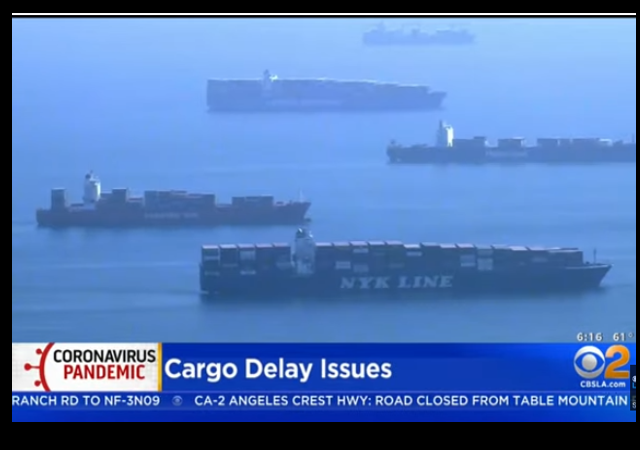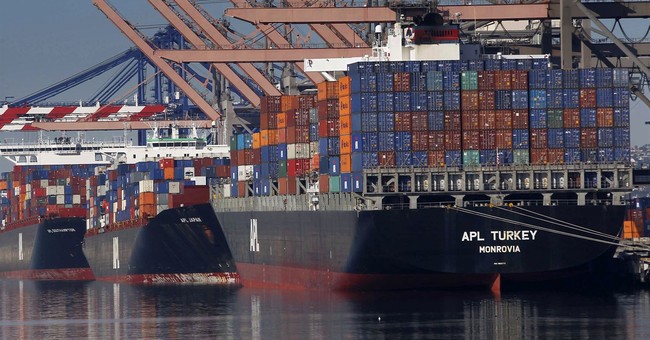You are using an out of date browser. It may not display this or other websites correctly.
You should upgrade or use an alternative browser.
You should upgrade or use an alternative browser.
ECON Inside America’s Broken Supply Chain How industry failures to collaborate and share information left the system vulnerable
- Thread starter marsh
- Start date
marsh
On TB every waking moment
ZeroHedge
ZeroHedge - On a long enough timeline, the survival rate for everyone drops to zero
Biden Plays Chicken With Semitruck Drivers
MONDAY, OCT 25, 2021 - 07:10 PM
Authored by Jackson Elliott, Cara Ding, Allan Stein, Steven Kovac, Jannis Falkenstern and Nick Ciolino via The Epoch Times,
American truckers don’t like taking orders. But the Biden administration has increased pressure on them to take the vaccine—willing or unwilling.
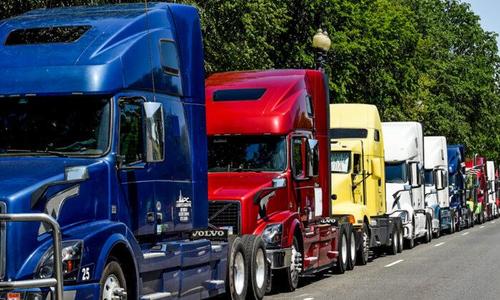
All through the pandemic, truckers endured hardships to keep America’s infrastructure running. They waited in line for hours in sight of bathrooms they weren’t allowed to use. On the road, some died alone of COVID-19.
Now, with supply chains disrupted, Americans need them more than ever.
But faced with the prospect of a forced vaccination, many drivers are considering quitting.
“I’d fight it,” said veteran trucker Mike Widdins, referring to vaccine mandates.
Widdins isn’t alone in his willingness to leave trucking if forced to vaccinate. Polls by trucking publications Commercial Carrier Journal and OverDrive indicate that up to 30 percent of truckers will seriously consider quitting if forced to vaccinate.“I think a lot of us will be quitting. Who likes to be forced to do stuff you don’t want to do?”
If they quit, the consequences for America may be massive. US Transport estimates that 70 percent of American freight goes by truck.
Narrowing Lanes“It would hurt shipping big-time,” Widdins said.
The Sept. 9 mandate establishes an “emergency standard” which the Occupational Safety and Health Administration (OSHA) is allowed to issue if it determines workers are in “grave danger.” Currently, the White House Office of Budget and Management’s Office of Information and Regulatory Affairs is reviewing the mandate. The review process can take as long as 90 days.
Most of the trucking industry will be unaffected by the Biden vaccine mandate, which demands that all companies with over 100 employees require vaccination or weekly COVID-19 tests.
Most truck companies have six trucks or fewer, according to the American Trucking Associations. Independent drivers make an average of $50,000 more per year than drivers at large companies.
Some experts say the selective reach of the mandate makes it ineffective. Barbara Smithers, vice president of the Indiana Motor Truck Association, told The Epoch Times via email that it makes little sense to “cherry pick” who to vaccinate based on company size.
“Truck drivers spend most of their work hours alone in the cab of a truck—literally one of the safest places possible during a pandemic—so why do they need to be regulated in this way?” she said.
For mandate-affected companies, Biden’s decision may drive away employees at a time when America needs them most. The American Trucking Associations estimates that America needs 80,000 more truckers to meet transportation needs.“Testing hundreds of thousands of truck drivers moving across the country every day is a virtual impossibility.”
Recently, supply chain crises have left many Americans in need. Transportation secretary Pete Buttigieg said the shortage will last as long as there’s a pandemic.
With backups unloading goods at America’s ports, shortages already threaten consumers. But if long lines of trucks waiting to ship goods suddenly become shorter, the crisis will become far worse.
Whether America runs short on trucks depends on the Biden administration’s orders and how truckers respond.
Joe Trucker and Joe Biden
The average trucker is a big, bearded guy with a sturdy, American name like ‘Joe.’
Joe Trucker is friendly given the chance, and he thinks of his job as his little service to America. He has a relative in the military somewhere, or he served himself. Toward government, he holds a strong suspicion that increases the more pressure he feels from it.
Joe Trucker doesn’t usually like interviews. If he doesn’t feel open to talking, he drops four-word answers like he tosses peanut shells from his window. In exchange for long hours away from home, he gets low pay, independence, and the nation’s best sunsets.
The CCP (Chinese Communist Party) virus hasn’t been kind to Joe Trucker. At a time when many Americans hunkered down at home, he was still on the road.
Trucking life during the pandemic was a series of frustrating restrictions, said trucker Victor Morales at a Georgia One9 truck stop.
Morales has driven trucks for 25 years.
After a long day on the road, Morales would wait for hours to drop off a truckful of deliveries at a warehouse. But warehouse owners didn’t allow truckers to leave their cabs for any reason.
If they arrived hungry, they waited hungry, he said. They weren’t even allowed to use the toilet only steps away.“You’re almost forced, like a second-class citizen,” he said.
“They want the goods and services you got, but they don’t even want you to get out of your truck.”
“You can literally see a bathroom right there behind the glass. But you can’t get out,” said Morales.
In the eyes of drivers, Biden’s mandate is the last step in a long line of restrictions that don’t consider their needs or wants.
For many drivers, the vaccine mandate may prove the final straw. Some drivers don’t trust the vaccine because of how new it is. Some distrust it for personal medical reasons. Others distrust it because they don’t trust the government.“It’s unconstitutional,” said one trucker who preferred to remain anonymous. “We’ll just buy our own damn trucks and run our own company. All we’ve got to do is shut down and the country doesn’t exist no more.”
McGregory said that he would rather quit than vaccinate.“I had cancer years ago,” said trucker Jack McGregory. “I don’t want to put something that I don’t know exactly what it will do into my body. If I die, I want to die with a little more time on my hands than that.”
But even those who take the vaccine say they oppose the mandate.
At the Pilot Truck Stop at I-69 and Wadhams Road in Michigan, all 10 truckers interviewed by The Epoch Times said they took the vaccine but oppose a vaccine mandate.
Kevin Hambrick, a longtime driver with Fortune 500 transportation company J.B. Hunt, opposes the mandate.
In Arizona, Florida-based truck driver Juan Martinez said that he knows life without freedom, having lived under Cuban communism. He also received a COVID-19 shot and opposes the mandate.“Each guy should make his own choice,” Hambrick said.
Many drivers feel pressured by their employers. After a year of difficult pandemic restrictions, it seems to them that COVID-19 rules grow ever more invasive.“You have to decide for yourself,” he said. “People should do whatever they want to do.”
In Flagstaff, Arizona, a long-distance truck driver in his late 20s asked not to be identified, fearing reprisal by his employer.
Other truckers who did not want to be named said they felt angry at those who mandated the vaccine.“There’s no place in the middle right now,” he said, adding “if you want to put something in your body, it’s your personal choice.”
“We run our country,” one said. “They don’t give a [expletive] about this country.”
Roads to Health
According to the Biden administration, America needs the new vaccine to increase protection against the CCP virus.
“The vast majority of Americans are doing the right thing,” president Joe Biden said in a press conference. But more people should get vaccinated, he added.
The current available vaccines block COVID-19 in most cases, according to CDC statistics.
Today, 79 percent of Americans over 18 are vaccinated, according to the CDC.
Experts say that this number might be enough to achieve herd immunity. But as the number of unvaccinated people has dwindled, pressure to increase vaccination numbers has increased.
Some medical experts say clusters of unvaccinated people allow the virus to mutate into a form that can bypass the vaccine.“We’ve been patient, but our patience is wearing thin,” Biden said to unvaccinated people. “Your refusal has cost all of us.”
“It’s perhaps just a matter of time,” University of Alabama at Birmingham medicine professor Dr. Michael Saag said. “A new variant could emerge where we won’t be so fortunate, and the existing vaccines won’t work.”
Another recent executive order suggested that the White House fears a truck shortage.
On Oct. 20, Biden announced an executive order that temporarily lifts weight restrictions on trucks and encourages more people to become truckers. The White House announced this order soon after the vaccine mandate.
Neither the White House nor the Department of Transportation responded to repeated requests for comment on this story.
Collision Course
Truck industry experts say that truckers with the option to quit will do so if forced to take the vaccine.
Joe Sculley, the president of Motor Transport Association of Connecticut, said that he sees a scenario playing out for those who oppose or refuse to comply with the mandate.
Right now, the supply chain crisis, the number of drivers who oppose forced vaccination, and the driver shortage leave the best cards in the hands of drivers, Sculley added.“Drivers will leave bigger companies and look for smaller ones that do not have to comply with the mandate, or they will quit altogether and look for another profession,” he said.
Jim Ward, president of D.M. Bowman and Chairman of the Truckload Carriers Associations, agreed that truckers are serious about quitting because of vaccine mandates.“Drivers have leverage,” he said. “It won’t be an empty threat. Nobody is going to be quickly replaced.”
“With driver availability already limited, any exodus due to compliance with a vaccine mandate would put our nation and its economy in an even more precarious situation,” he said.
Ward added that drivers who quit can’t easily be replaced. They require training.
Biden’s best chance to bring in new drivers comes from a pilot program in his recent infrastructure bill. The program would create a “test group” of 18- to 21-year-olds who would be followed to “see how they would perform,” Sculley said.“Our nation’s professional truck drivers are the safest, most well-trained operators on the road today. Replacing any driver who leaves the industry is not an overnight process,” he said.
However, the American trucking industry has long faced a driver shortage. Long hours away from home and mediocre pay doesn’t attract new drivers to the business, even when they have the right skills.
Impact
New workers also might not compare with longtime professionals. Experienced truckers thread their trucks through a complex ballet of traffic conditions and federal regulations to arrive on time.
Football games, the Kentucky Derby, hurricanes two states over, and other issues can all mean higher traffic along a route, said Morales.
“I’m not a sports fan. But I know when the playoffs are,” he said.
If Biden’s mandate goes through, the most experienced truckers are most likely to quit, Morales said.
In 10 years, nearly 30 percent of truckers will be 65 or older, according to Department of Transportation statistics. Often, these drivers make more money and have cash saved up, said Morales.
“The mandate is going to affect the older drivers that have been here a while,” he said. “They’re gonna have a choice.”
If these drivers retire early, it will be a challenge to replace them. To become a trucker, a driver must pass his commercial driver’s license (CDL) test, a process which usually takes four to seven weeks. During the pandemic, many truck driving schools closed, and training schools issued at least 100,000 fewer CDLS.
Short-term truckers are often unreliable, said small truck company owner Pete Falkenstern. He calls them “cowboys.”
If 20 percent of truckers quit because of the mandate, America will lose about 15 percent of its transportation capacity.“If somebody’s done it for a long time and hasn’t had a lot of accidents, they’ve been pretty safe,” he said. “They probably take some pride in what they do.”
America’s infrastructure relies most on trucks. As a transportation system, trucks are incredibly flexible. They can go anywhere at any time, can carry many kinds of goods, and are the most cost-effective form of transportation over short to medium distances.
“I love this industry, but without us this country would shut down in three days,” said trucker Jack McGregory.
Even so, the trucking industry has a high turnover rate.
Backing Up
The vaccine mandate will only directly affect companies with over 100 people, but small truck companies won’t have the required resources to absorb many additional drivers, Falkenstern said.
“I would love to be able to accommodate 30 people, but the work is not here to support that many,” he said. “I don’t want to operate any more than what I have because of insurance regulations.”
Large truck companies also tend to be cheaper, said Falkenstern. They can buy things in bulk and self-insure.
“A lot of the bigger companies can keep prices down,” he said. “They can get a lower cost because it’s in bulk.”
Cathy Roberson, the founder and president of Logistics Trends and Insights LLC, said it’s unclear right now what the long-term impact of the vaccine mandate will be.
If truckers quit, the mandate could damage America’s logistics system, Robertson said. But if they switch to smaller companies, Biden’s executive order might only reshuffle employees.
Whatever the case, the mandate will exacerbate current supply chain issues, she said.“It really hurts the larger trucking companies more than anything else,” Robertson said.
Already, logistics workers wrestle with the worst supply chain issues ever seen, said Lisa Anderson, the president of logistics group LMA Consulting.
Right now, logistics issues have made it difficult to find replacement parts for trucks, she said. Businesses find themselves in a catch-22 situation; To fix their trucks, they need trucks to transport parts. The supply chain feeds itself.“It’s unprecedented. It’s never happened before,” she said.
Anderson said the vaccine mandate will almost certainly worsen the driver shortage. Truckers are independent-natured.
“They are more of a lone wolf, always navigating complex situations on their own,” she said. “They don’t like to be told what to do.”
Delays Ahead
If truckers follow through with what they say they will do, America’s supply chain crisis may soon become far worse.
From a perspective based purely on material benefits, it seems like it’s only logical to obey the mandate. Truckers can take an effective vaccine, keep their jobs, and keep the national supply chain running.
But human beings often want to assert that they amount to more than mere links in a chain, pulling on command from the federal government. The logic of individual freedom doesn’t calculate for material benefits.
“It’s just that shoving-it-down-your-throat part,” Morales said. “Our first instinct will be to push back.”
marsh
On TB every waking moment
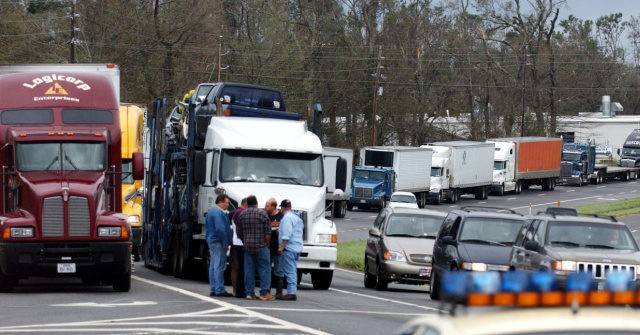
FL Wants Truckers: Up to $110,000 Annual Salary, $15K Signing Bonus
Florida is hoping to hire more truck drivers, with some companies offering high salaries and signing bonuses.
Florida Wants Truckers: Offers up to $110,000 Annual Salary, $15,000 Signing Bonus
133
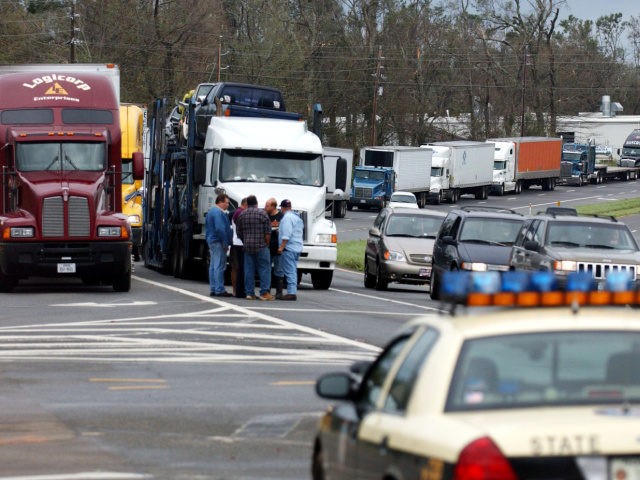
PENNY STARR25 Oct 202180
Truckers are key to delivering products to consumers around the United States and Florida is hoping to hire more in the state to help restore the broken nationwide supply chain.
According to the American Trucking Associations, the industry is facing a shortage of an estimated 80,000 drivers.
A Jacksonville, Florida, television station reported on how the state is trying to attack truckers, including distributor Sysco, which is offering salaries of up to $110,000 a year and a $15,000 bonus.
News4 interviewed Florida truck driver Thomas Glass, who said not only are drivers getting good deals, but his company is paying referral bonuses.
“The bonus has been between three to five thousand dollars just to refer somebody to drive,” Glass said.
“It’s a good career,” Glass said. “It’s going to allow you to see some things that you’ve never seen before. You’re going to experience some things you’ve never experienced before.”
ABC reported on the role trucks play in the U.S. supply chain:
[Brad] Ball has been in the trucking industry for 25 years and now leads Roadmaster Drivers School. He says the truck driver shortage had been an issue prior to the pandemic.
“We have trucking companies calling me every single day, calling our schools every single day, trying to figure out how to hire more drivers,” Ball said.
In his annual State of the Industry and Association Address, published on its website on Monday, American Trucking Associations President and CEO Chris Spear praised the industry’s efforts to keep the country moving through the coronavirus pandemic and how it has continued work to address issues critical to trucking.Ball says even with incentives like higher pay and tuition reimbursement, it’s hard to find help. ABC Action News checked the job listing site, Indeed. There are nearly 1,200 open truck driver jobs in Tampa [Florida] alone.
“Throughout this pandemic, truckers proved how we make a difference,” Spear said. “There was no playbook. Yet our drivers are once again this industry’s most valuable players.”
“You’re among an elite list of professionals that include scientists, first responders, and healthcare providers,” Spear said. “When many in this nation sheltered in place, you maintained composure and answered the call.”
marsh
On TB every waking moment

White House Clarifies: Biden Not Considering Using National Guard To Support L.A. Port Cargo Operations
Meanwhile, Gov. DeSantis says Florida ports are open for business and have the capacity needed!
White House Clarifies: Biden Not Considering Using National Guard To Support L.A. Port Cargo Operations
Meanwhile, Gov. DeSantis says Florida ports are open for business and have the capacity needed!
Posted by Leslie EastmanMonday, October 25, 2021 at 09:00am57 Comments
In a development that should surprise no one, the move hasn’t helped. So now Team Biden indicates that it may use the National Guard could help with the cargo ship bottleneck at the ports of Los Angeles and Long Beach.
The White House later clarified that the use of the National Guard is up to the state and its governor:A White House administration official confirmed to CNN Wednesday that it is considering all its options, including deploying the National Guard.
When asked specifically about whether President Joe Biden would consider ordering the National Guard or Navy to help unload cargo stacked up at ports or drive trucks, White House Press Secretary Jen Psaki said Tuesday, “I’m not here to take options off the table,” according to CNN.
The White House then clarified that if the National Guard does step in to help mitigate supply chain issues, it will be a decision made by individual states.
The new route options have caused trouble for residents in neighborhoods near the port.“Requesting the use of the National Guard at the state level is under the purview of governors, and we are not actively pursuing the use of the National Guard on a federal level,” the White House said in a statement.
Governors in some states are considering or have called in the National Guard to ease labor shortages. In September, Massachusetts Gov. Charlie Baker sent some 250 Guard members to take driving duties in school districts that were reporting severe shortages of school bus drivers, in part due to the state’s COVID-19 vaccine mandate for public employees.
Valerie Contreras, a board member of the Wilmington, California, Neighborhood Council, told “Fox & Friends First” Thursday that the dangerous situation can’t continue.
“The shipping industry is spilling over into our community and we cannot sustain it any longer,” Contreras said.
“We have had these truckers going through our community. Our residential streets are backed up and we cannot handle the overflow of what’s happening at the port. And it’s quite dangerous.”
One car was photographed being crushed by a container in the harbor area of Los Angeles.
Union Pacific representatives indicated that expanding the hours is not going to quickly fix the cargo ship backlog, either.“This particular container of the driver pulled around the corner,” Contreras said. “It disconnected from his fifth wheel and fell completely and crushed this car.”
In response to the developing issues that are arising from the “solutions”, California Governor Gavin Newsom signed an executive order to provide more container storage options.Union Pacific executives and other logistics experts say that a shortage of available warehouse space and port and long-haul truckers are stymieing efforts to keep up with the surge in cargo to the United States – where the world’s most avid consumers have been buying more goods than ever due to pandemic-related curbs on travel and entertainment.
Alternatively, companies that rely on shipping for product transport may consider diverting to Florida. Governor Ron DeSantis indicates the state’s ports are open for business.The executive order directs state agencies to find state, federal and private land for short-term container storage while identifying freight routes for trucks so the state can temporarily exempt weight limits on the road.
“Our ports operate 24/7, I mean, that should be happening anyway,” the governor said. “We in Florida have the ability to help alleviate these logjams and help to ameliorate the problems with the supply chain.”
“We’re here, we have capacity,” he emphasized.
The governor said JAXPORT and other Florida seaports are further offering incentive packages to businesses that want to send cargo through the facilities, noting that companies in other parts of the globe have already begun rerouting shipments from logjammed ports to Florida.
5:01 min
marsh
On TB every waking moment
Clogged California Ports Are Finally Getting Some Much-Needed Help. Will It Be Enough?
BY GWENDOLYN SIMS OCT 25, 2021 10:19 AM ET
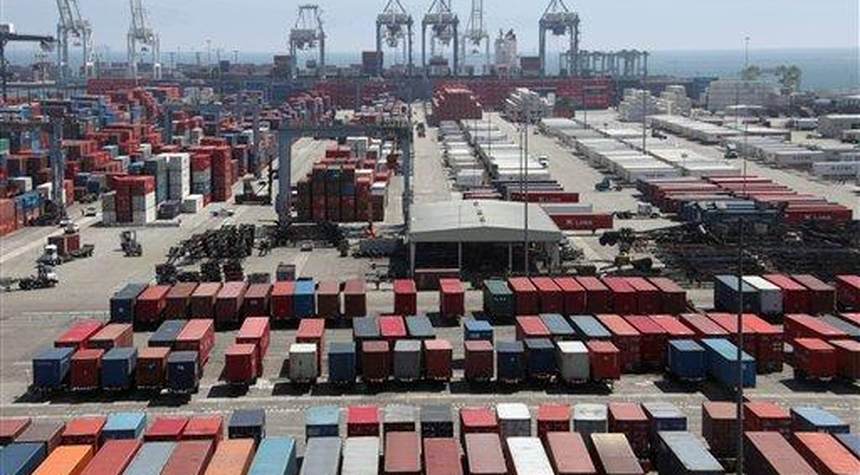
More than a week after President Joe Biden announced his ineffective plan for the clogged Los Angeles ports to increase their work hours, California Gov. Gavin Newsom has finally issued an executive order “to address state, national and global supply chain challenges” at the p;]ports.
According to an official Governor’s Office press release, Newsom’s Executive Order N-19-21 “directs state agencies to continue coordinating with the Biden-Harris Administration Supply Chain Disruptions Task Force to address state, national and global supply chain challenges. The executive order also directs the Department of Finance to work with state agencies to develop longer-term solutions that support port operations and goods movement for consideration in the January 10 Governor’s Budget, which may include port and transportation infrastructure improvements, electrification of the goods movement system from port to delivery, and workforce development.”
The executive order also “directs state agencies to identify state-owned properties and other locations that could be available to address short-term storage needs once goods are unloaded from ships; to identify priority freight routes to be considered for a temporary exemption to current gross vehicle limits to allow for trucks to carry additional goods; and to create workforce training and education programs.”
Sounding similar to logistics expert Ryan Petersen’s five-step plan to fix the bottleneck at the Los Angeles ports I wrote about here a few days ago, one can’t help but wonder if Newsom was actually listening. Who knows for sure?
Someone who does appear to have heard is Long Beach City Manager Tom Modica who said Friday in a press release that it had “recently come to the City’s attention the Municipal Code contains zoning provisions that limit the number and/or height of shipping container storage, that if relaxed for a short time could provide some assistance during this national crisis.”
“Given this current national emergency and the Governor’s Executive Order to take necessary steps to alleviate the impacts on the system,” the press release said. “The City Manager will temporarily waive enforcement of current shipping container stacking and height limits for a period of 90 days from October 22, 2021. During this period, affected operations will be allowed to stack up to four (4) shipping containers without being cited for a Code violation.”
While this waiver only applies to properties currently zoned to allow shipping container stacking, it should help alleviate some of the container back-ups at the ports. These steps are certainly good news for our ports, our nation’s supply chain, and the American consumer, however, there’s much more that needs to be done. These steps are vital to getting our ports working again. It’s so detrimental to the world economy if the ports don’t work because every company that buys or sells physical goods internationally will fail if we allow the supply chain of our globalized economy to collapse.
subnet
Boot
"Fundamental change" is the name of the gameDid it break, or was it broken deliberately?
The original story was an extremely long winded request for federal control.
If the author was honest he would likely find a large amount of the blame is directly the result of administration policies and leftist demo run coastal state moronic governors, and the reliance on Chinese goods flowing through California ports.
And the solution is give these morons more control?????
See definition of insanity...
Lessons learned.
China in an emergency will take care of China and give the middle finger to the rest of the world.
California cannot be relied on in any emergency because of leftist progressive leaders in the state.
Obama is an even worse president running things from the shadows as he was when he was in the oval office.
Complex problems can never be solved by the government. Unless it was the military before the election theft.
If the author was honest he would likely find a large amount of the blame is directly the result of administration policies and leftist demo run coastal state moronic governors, and the reliance on Chinese goods flowing through California ports.
And the solution is give these morons more control?????
See definition of insanity...
Lessons learned.
China in an emergency will take care of China and give the middle finger to the rest of the world.
California cannot be relied on in any emergency because of leftist progressive leaders in the state.
Obama is an even worse president running things from the shadows as he was when he was in the oval office.
Complex problems can never be solved by the government. Unless it was the military before the election theft.
marsh
On TB every waking moment
5:19 min
The shipping crisis is even worse than you think — here’s why
Oct 26, 2021
The Daily Wire
Have you been seeing more empty shelves at grocery stores and shopping malls? Here is why your favorite items are missing and how long it will take for them to get back in stock.
marsh
On TB every waking moment
ZeroHedge
ZeroHedge - On a long enough timeline, the survival rate for everyone drops to zero
Why Supply Chain Disruptions Will Persist
TUESDAY, OCT 26, 2021 - 09:50 PM
Just-in-time (JIT) is a production model used by companies to create items for immediate demand. The point of JIT is to avoid the waste associated with overproduction. But when supply chain snarls appear, JIT has become a significant headache for US companies such as Ford who has had to shutter multiple vehicle plants because of their inability to source semiconductor chips.
Companies are rethinking their production model to just-in-case inventory (JICI), a more suitable model in today's challenging environment that allows more inventory to be stored and will help ensure future orders are filled.
JIT still dominates the corporate world, but JICI could make a strong comeback due to global uncertainties. Bloomberg has provided an in-depth view of various US industries and their potential disruptions in foreign supplies.
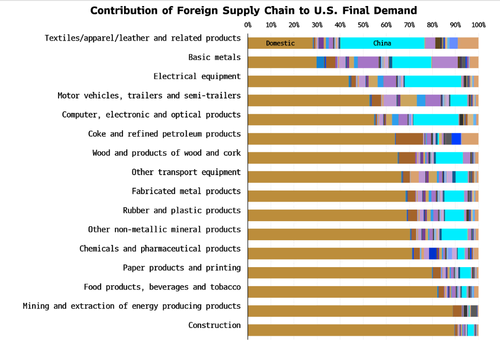
Source: Bloomberg
Foreign supply-chain production is the largest in textiles, basic metals, electrical equipment, motor vehicles, and electronics. Many of these industries are entirely reliant on production from China. The problem with that is Beijing has ordered energy-intensive factories to shutter operations to conserve electricity amid a massive energy crunch. This will complicate the picture for firms that source a majority of their goods from the country. On top of this all, port congestion on either side of the Pacific continues to increase to record levels.
JIT is a flawed production model when supply chains break. Maybe companies will learn to transition to JICI and hold inventory in case of a rainy day.
For more insight on when global supply chain bottlenecks will subside, Dubai's DP World, one of the biggest international port operators, Chairman and CEO Sultan Ahmed Bin Sulayem told Bloomberg earlier this month that disruptions could last for another two years.
So the complex, interconnectedness of the global supply chain combined with JIT is a recipe for disaster in today's brave new world. This suggests that more US corporates could embrace JICI and diversify their supply chains away from China to mitigate risk."The global supply chain was in crisis at the beginning of the pandemic," Bin Sulayem said. "Maybe in 2023 we'll see an easing."
marsh
On TB every waking moment
ZeroHedge
ZeroHedge - On a long enough timeline, the survival rate for everyone drops to zero
"Transitory" Shortages & Inflation Are Actually Your Quality Of Life Being Stolen Right Before Your Eyes
TUESDAY, OCT 26, 2021 - 06:30 AM
Submitted by Quoth the Raven at QTR's Fringe Finance,
There’s no doubt our country has all of a sudden slipped into the most precarious state we’ve been able to readily confirm with our own two eyes in decades.
We are suffering from runaway inflation, we have a monstrous labor shortage, and products we normally would have abundant access to are missing from store shelves. The country doesn’t produce anything anymore, we have doubled our Central Bank’s balance sheet in under two years and the money supply has gone parabolic.

Source: Minn Post
And engineering solutions for these issues requires correctly identifying where the problem is coming from to begin with. It appears we can either go one of two directions when we try to deduce the cause of these issues.
The first direction we can go in is to point to monetary and fiscal policy and look at their direct effects on the state of the country and our economy. This, I believe, is the pragmatic approach to solving the issues our nation faces.
The second direction, according to a new Washington Post op-ed, is apparently to blame and shame ourselves for being greedy and assuming that we ever deserved such a quality of life to begin with.
The Post recently published a piece called "Opinion: Don’t rant about short-staffed stores and supply chain woes”, which put this argument on the table, basically telling people to shut up and be thankful for the little they have.
While normally I embrace the idea of being humble and thankful no matter how much or how little you have access to, the Post’s opinion piece brings an interesting concept into the foreground that I want to examine: what I am calling “the quality of life con”.
Let’s have a look at what the op-ed, written by award winner Micheline Maynard, argues. Maynard’s website notes that prior to working at the Washington Post, she worked for The New York Times and NPR.

Micheline Maynard, via michelinemaynard.com
In the op-ed, a photo of empty store shelves - very similar to the ones I used to effectively make my argument that the U.S. is turning into a third world country - accompanies an argument that it’s “time for some new, more realistic expectations,” as “Americans’ expectations of speedy service and easy access to consumer products have been crushed like a Styrofoam container in a trash compactor.”
"American consumers, their expectations pampered and catered to for decades, are not accustomed to inconvenience," the op-ed states.
Its a convenient argument to make now, since when I make this “anti-comfort” argument about the importance of having a recession/depression and the Fed not stepping in the way every time those very same pampered consumers feel a little bit of financial unease, it is the left that casts me away as a conspiracy theorist and lunatic for advocating ushering in discomfort. Now, all of a sudden, because their policies brought on discomfort, the narrative changes to “lets all stop being so pampered all the time”.
"Rather than living constantly on the verge of throwing a fit, and risking taking it out on overwhelmed servers, struggling shop owners or late-arriving delivery people, we’d do ourselves a favor by consciously lowering expectations," the piece says.
While I agree with not taking out our rage on service workers, like bartenders and servers - I was one for more than a decade and can tell you firsthand it doesn’t accomplish anything - this continues to fall under the “simply don’t be a dick” ruleset, and has nothing to do with “consciously lowering expectations” for our quality of life across the board.

Source: New Westminster Record
And this segues nicely into my discussion about what I have called “the quality of life con.”
Seeing the left finally address our quality of life marks an interesting paradox for them. Often, I have argued that our quality of life deteriorating is one of the hidden gears that turns in the background as a result of rising inflation and poor monetary policy in our country.
Quality of life needs to be talked about loudly because it can (and will) be whittled away at without being noticed until, one day, you wake up and your quality of life is much poorer than it was years ago. This is akin to the “weighted blanket theory” case against the Federal Reserve I made on YouTube earlier this year: it falls on you slowly, and you don’t notice it until it’s too late.
On a day by day basis, quality of life can be washed away by things like shrinkflation, higher prices, and exactly what Maynard is arguing for in her op-ed: lowered expectations.
The convenient thing about lowered expectations is it makes it easier to not notice when your quality of life is being stolen from you. And I say “stolen” because if you are a normal productive, taxpaying member of the country, you would assume that your quality of life should improve or at least hold steady.
After all, that is what most of the point of productivity as a part of capitalism is. It is what has gotten us from black and white televisions with two channels to 100 inch plasma screen TVs playing whatever we want, on demand from the internet, in the course of just a couple of decades.
And it seems to be that everyone can agree in unison - both the left and the right - that we all want our quality of life to improve. We measure the success of our country by things like GDP, infant mortality rate and life expectancy, all numbers that tend to improve as our quality of life improves.
I have made the argument that quality of life is a very subjective measure that is difficult to wrap our heads around, and this is why cultural Marxists in our country think that they can implement time-tested destructive ideologies, but will still be able to walk around with their iPhones and their Starbucks lattes in the years following their successful overthrow of capitalism.
They don’t understand that their quality of life will not remain the same under such policies.
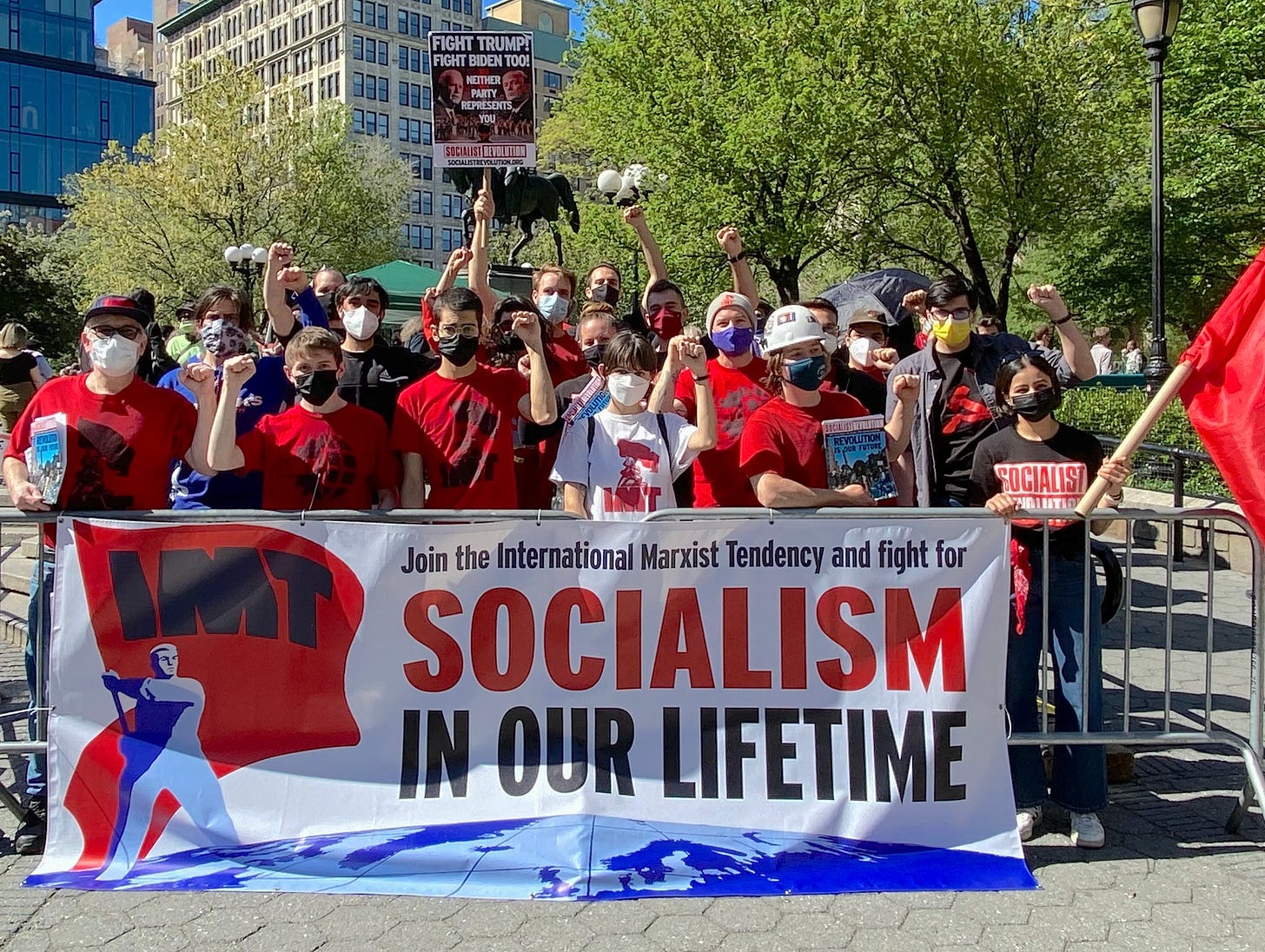
Source: Socialist Appeal
But because there is no real way to measure or model quality of life on a minute-by-minute basis in most households, and because the left doesn’t seem interested in looking at history for the answer, quality of life becomes this subjective gray area that can be used as a dumping ground for ideological screw-ups when convenient and, in the case of this WaPo op-ed, as a lever to try to get the American public to accept the consequences of the failed policies that led us to inflation and product shortages to begin with.
Again, I think it is appropriate to always be thankful and humble about what we have, but we should stand firm in the expectation that we want our quality of life to continue to progress instead of regress.
The left swears that socialism and Marxism are the best ways to help those in our country and outside of our country who are in need. But the truth is we can best help the rest of the world - and humanity as a whole - by ensuring that our own two feet are firmly planted in the ground first, and that our quality of life remains, at worst, steady. This is why, on an airplane, they ask you to put on your mask first before helping others with their masks.
And so, without even knowing that she was doing it, the author of this op-ed is using quality of life as a dumping ground to try and divert the consequences of insane monetary and fiscal policy.
She’s also bringing to the foreground a concept that, if we paid more attention to it, could help us understand far more deeply why our policies are flawed to begin with.
The point is we should not be happy about the fact that the country is devolving before our eyes, we should not accept the theft of our savings via inflation and we should keep a keen eye on our collective quality of life as a country.
After all, quality of life is what decades of rugged productive individuals in this country fought for at war and worked for back home.
I think my point is best made through Maynard’s own words.
Very likely unaware of some of the historical analogues she was making, she wrote:
"The other day I found myself carrying home a loaf of bread in my bare hands because the bakery had run out of bags. Back when we didn’t know how good we had it — circa 2019 — I might have been annoyed by the inconvenience. Now I was just glad the bakery was still in business."
Shadow
Swift, Silent,...Sleepy
Lots of well written articles that miss the point. The governor will not allow trucks more than a few years old to operate in California and when even the new trucks are used independent operators are not allowed at the docks. The independents have been credited with moving most of the freight in the past.
Any argument that this backlog problem is not by design and intent would be very hard to support.
Shadow
Any argument that this backlog problem is not by design and intent would be very hard to support.
Shadow
West
Senior
Lots of well written articles that miss the point. The governor will not allow trucks more than a few years old to operate in California and when even the new trucks are used independent operators are not allowed at the docks. The independents have been credited with moving most of the freight in the past.
Any argument that this backlog problem is not by design and intent would be very hard to support.
Shadow
But it's environmentally right and those owner operators are evil capitalist!
That's getting to the bone of why it's not reported on. PC BS is killing us.
marsh
On TB every waking moment
ZeroHedge
ZeroHedge - On a long enough timeline, the survival rate for everyone drops to zero
Congested Port Of LA Receiving Empty Containers From Gulf, Southeast
WEDNESDAY, OCT 27, 2021 - 01:52 PM
By Lori Ann LaRocco of FreightWaves,
American Shipper is reporting another wrinkle facing the Port of Los Angeles as it tries to clear the massive congestion. Thousands of additional empty containers are en route to the Port of Los Angeles from East Coast and Gulf Coast ports.
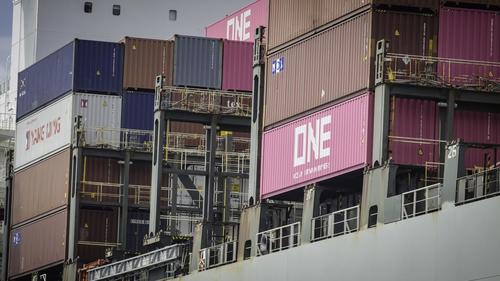
Over the last couple of weeks, up to 2,000 empty containers originating from the ports of Charleston, South Carolina; Savannah, Georgia; New Orleans and Houston were headed to the Port of Los Angeles to be loaded onto vessels.
These containers were requested by the carriers and will create more burden for the port terminals to receive local trucks trying to unload their own empty containers.
“The biggest hurdle we see in the market is the inability to return empty containers,” said Weston LaBar, head of strategy at Cargomatic.
“This congests our carrier and customer yards and adds to the chassis shortage. Ultimately this can delay the ability to pick up imports due to the shortage in chassis availability and yard space.
The phenomenon of containers traveling from other ports to Los Angeles is not a new one. Local truckers tell American Shipper the port is known to be the “empty container dumping ground in the country.”“We have customers whose warehouses can receive goods; however, the lack of chassis and space in their yards due to the stranded empties impacts the ability to keep a delivery cadence.”
The reason for the carriers moving containers from the East Coast either by truck or rail to the West Coast is time. The LA trade route to China is faster than the maritime routes from the East Coast and Gulf Coast ports.“Even containers from Port Rupert [in British Columbia, Canada] have made their way down to Los Angeles via rail,” said one trucker who requested anonymity. “This is making a bad situation worse. There is a finite number of slots to return empties. How can we pick up empties if we can’t unload our chassis?”
Despite the claims of 24/7 ports by the Biden administration, the Port of Los Angeles is still in talks with the various port stakeholders to seek participation. In an effort to expand service, the port is opening gates at 7 a.m. PT and on weekends so truck drivers can return empty containers and pick up loaded boxes.
But because of the lack of warehouses open during the flex time and on weekends, coupled with the container restrictions that are imposed by the terminals at the order of the ocean carriers, appointments are being left unused.
According to the Port of Los Angeles, 50% of weekend appointments have been left open and 30% of weekday appointments remain unused.
The Harbor Trucking Association says the surge of extra containers will only add to the already stressed system.
The acceptance of empty containers at the Port of Los Angeles is on a first-come, first-served basis. That means if the terminal hits its empty container allotment at noon and a trucker arrives at 12:05 p.m., he or she will be turned away with a full chassis and cannot pick up a loaded container.“We are trying to free up chassis, but we can’t because we are competing with these additional empties contracted by the ocean carriers,” said Matt Schrap, Harbor Trucking Association CEO. “This is not helpful for the supply chain.”
This photo given to American Shipper by port sources illustrates the unused truck appointments. The photo was taken from the APM Terminal at 7:38 a.m. PT at the Port of Los Angeles last Wednesday. It was a flex gate and opened at 7 a.m. The first appointment was a Walmart tuck at 9:45 a.m.
“We’ve been more successful than the market at threading this needle for our customers,” said LaBar. “But an increase in empties coming from the East Coast, Gulf Coast and even Canadian ports should be a cause for concern for everyone servicing and using the Southern California ports.”
marsh
On TB every waking moment
ZeroHedge
ZeroHedge - On a long enough timeline, the survival rate for everyone drops to zero
Ports Of Los Angeles, Long Beach To Fine Shipping Companies For Staying Too Long In Marine Terminals
WEDNESDAY, OCT 27, 2021 - 09:20 AM
Authored by Katabella Roberts via The Epoch Times,
Shipping companies at the ports of Los Angeles and Long Beach will soon be fined if their containers stay in marine terminals for too long, officials announced on Monday.

Officials at San Pedro Bay Ports said in a statement that the fines are being imposed in an effort to “improve cargo movement amid congestion and record volume.”
Starting on Nov. 1, the ports will charge shipping companies that fall into one of two categories: containers scheduled to move by truck and containers moving by rail.
In the case of containers scheduled to move by truck, shipping companies will be charged for every container that stays in marine terminals for nine days or longer. For those moving by rail, shipping companies will be charged if the container stays for three days or more.
Companies will incur a fine of $100 per container, which will increase in $100 increments per container per day. The fees collected will be re-invested into programs aimed at enhancing efficiency accelerating cargo velocity, and addressing congestion impacts throughout the San Pedro Bay, officials said.
“We must expedite the movement of cargo through the ports to work down the number of ships at anchor,” Port of Los Angeles Executive Director Gene Seroka said in a statement.
The new policy was developed in coordination with the Biden-Harris Supply Chain Disruptions Task Force as well as the Department of Transportation and various supply chain stakeholders.“Approximately 40 [percent] of the containers on our terminals today fall into the two categories. If we can clear this idling cargo, we’ll have much more space on our terminals to accept empties, handle exports, and improve fluidity for the wide range of cargo owners who utilize our ports.”
President Joe Biden has attempted to alleviate supply shortages and disruptions before Christmas, but experts say that the process will take far longer.
Roughly 77 ships are currently waiting outside docks in the Ports of Los Angeles and Long Beach, California, carrying a staggering $24 billion worth of goods waiting to be offloaded, CNBC reported, citing economists at Goldman Sachs.
And according to Goldman economist Ronnie Walker, the situation does not look set to improve in the immediate future as officials struggle to find a solution to the issue.
About 250,000 containers of goods are currently stacked up on the docks due to delayed pickups from chassis shortages and a lack of space in railyards and warehouses. This is causing dozens of ships to back up at anchor outside the ports.“Backlogs and elevated shipping costs are likely to persist at least through the middle of next year because no immediate solution for the underlying supply–demand imbalance at U.S. ports is available,” Walker said in a note to clients earlier this week.
The situation has resulted in shipping containers taking triple the time they usually take to get through major U.S. ports, according to CNBC.
Earlier this month, the White House released a statement saying it received confirmation from UPS, FedEx, Walmart, and other companies, as well as the Port of Los Angeles, to increase the number of shifts to deal with a backlog of container ships, labor shortages, and warehousing issues.
Biden also threatened on Oct. 13 to “call out” private companies who fail to assist his administration and step up to address global supply-chain bottlenecks.
The federal government said it will be working with multiple stakeholders across the supply chain for a 90-day period until the end of the year in an effort to alleviate bottlenecks.“If the private sector doesn’t step up, we’re going to call them out and ask them to act,” he said in remarks at the White House.
“I support the actions taken by the ports of Los Angeles and Long Beach today to charge ocean carriers for lingering containers on marine terminals.
These actions aim to expedite the movement of goods and reduce congestion in our ports,” said John D. Porcari, Port Envoy to the Biden-Harris Supply Chain Disruptions Task Force.
marsh
On TB every waking moment

'So Many People Are Purchasing Goods Online' - Biden White House Blames Americans For Supply Chain Crisis (VIDEO) | The Gateway Pundit | by Cristina Laila
White House Press Secretary Jen Psaki on Wednesday blamed Americans for the supply chain crisis.
‘So Many People Are Purchasing Goods Online’ – Biden White House Blames Americans For Supply Chain Crisis (VIDEO)
By Cristina Laila
Published October 27, 2021 at 6:10pm
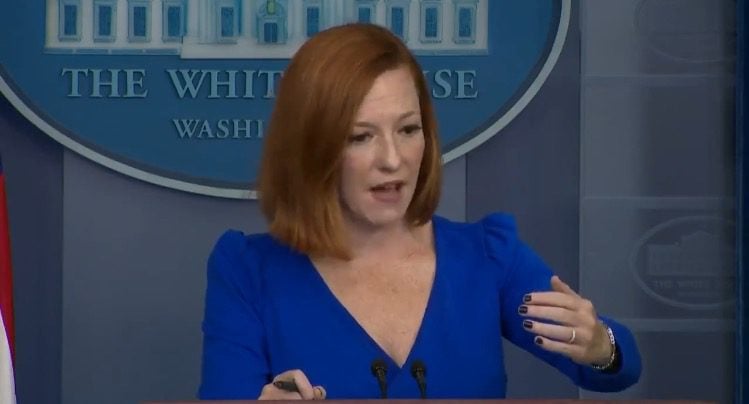
White House Press Secretary Jen Psaki on Wednesday blamed Americans for the supply chain crisis.
Psaki said Americans purchasing too many goods online is the “root cause” of the supply chain crisis thanks to a labor shortage created by Joe Biden.
“What’s your message to Americans who are still so worried about getting their Christmas gifts on time?” a reporter asked Psaki.
Psaki blamed Americans and claimed the supply chain crisis is a minor scalability issue due to the popularity of online shopping.
“So many people across the country are purchasing more goods online. Maybe some of it is from habits that developed during the pandemic when people weren’t leaving their homes. Some of it is because we’ve seen an economic recovery that has been underway…” Psaki said.
According to the American Trucking Association, the industry is short 80,000 truck rivers which in turn has caused cargo ships to be anchored off the coast of Southern California.
Meanwhile, Transportation Secretary Pete Buttigieg is on extended paternity leave as the crisis gets worse going into the holiday season.
Psaki has no shame.
VIDEO:
View: https://twitter.com/i/status/1453432736027394050
.47 min
vector7
Dot Collector
"Empty Shelves Joe" | Buddy Brown | Truck Sessions (3:11)
Oct 27, 2021
View: https://youtu.be/NCbVg0dYucE
Oct 27, 2021
marsh
On TB every waking moment
ZeroHedge
ZeroHedge - On a long enough timeline, the survival rate for everyone drops to zero
Coast Guard Says 100 Containers Fell Off Cargo Ship, Some Carrying Christmas Decorations And Toys
THURSDAY, OCT 28, 2021 - 07:20 PM
The Canadian Coast Guard released an update on the number of truck-size intermodal shipping containers that fell into the Pacific Ocean from a container ship during rough seas last week to more than 100, up from the original estimate of about 40.
The Maltese-flagged ZIM Kingston container ship hauled 2,000 containers with 1,000 on deck when stormy seas near Vancouver Island on Oct. 22 knocked 106 containers into the ocean. After the incident, two of the containers containing hazardous chemicals caught fire. The fire has since been extinguished, and the vessel is anchored at Constance Bank, in the Straits of Juan de Fuca off of Victoria, British Columbia.

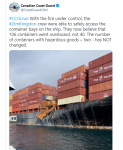
Some of the contents lost at sea include car parts, industrial parts and machines, Christmas decorations, clothing, toys, sofas, poker tables, and other everyday items. There are reports that some of the containers have washed ashore.
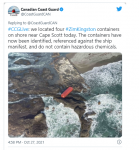
View: https://twitter.com/i/status/1453804031042785285
.22 min
A majority of the containers sunk:
The incident comes as global supply chains are more snarled than ever, forcing container ships to stack containers to the brim in a technique called containerization. The more containers loaded up on a vessel, the more prone it becomes to an accident at sea in adverse weather conditions. That's precisely what happened to ZM Kingston."They're out there being battered in heavy seas," said Mariah McCooey, Canadian Coast Guard deputy federal incident commander. "The watertight integrity is not that great."
marsh
On TB every waking moment
ZeroHedge
ZeroHedge - On a long enough timeline, the survival rate for everyone drops to zero
Shippers Fear "Catastrophic" Fallout From "Crazy" California Port Fees
THURSDAY, OCT 28, 2021 - 03:01 PM
By Greg Miller of FreightWaves,
The cure is worse than the disease, say critics of an emergency plan of the ports of Los Angeles and Long Beach backed by the Biden administration. If you think port congestion is bad now, just wait for what comes next.
On Wednesday, two days after the ports of Los Angeles and Long Beach announced a surprise emergency fee for containers lingering too long at terminals, the National Shippers Advisory Council (NSAC) held its inaugural meeting. NSAC, created to advise the Federal Maritime Commission, is composed of 12 U.S. importers and 12 exporters. Members include heavy hitters like Amazon, Walmart, Target, Office Depot and Ikea.
Council members had a lot to say about the California port fees — none of it good.
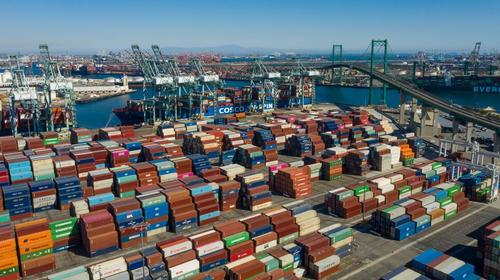
Port of Long Beach
‘I think it will be catastrophic’
Starting Nov. 1, the ports of Los Angeles and Long Beach will charge $100 per container for boxes dwelling nine or more days that move by truck and those dwelling six days or more that move by rail.
The fee will increase $100 every day. It will be charged to carriers, which will then almost certainly pass the fee along to shippers, meaning it will be the equivalent of an escalating demurrage charge.
“As far as the ‘hyper-demurrage’ announced in Los Angeles/Long Beach, I think it will be catastrophic,” said Rich Roche, vice president of international transportation at Mohawk Global Logistics, during the NSAC meeting.

“Chassis are already in short supply and this will artificially suck out the rest of the containers that may be sitting in there [at terminals] that didn’t need to be on a chassis and now they’re going to be parked somewhere. It’s probably going to wipe out whatever’s left in terms of chassis,” predicted Roche.
According to Steve Hughes, representing the Motor Equipment & Manufacturing Association, “I’m concerned that this new fee is going to cause even more problems than it’s going to solve. I understand the logic behind it and it makes some sense, but unfortunately, because we don’t have the throughput at the front gate, I think this can cause us more problems than we have already.”
Bob Connor, executive vice president of global transportation at Mallory Alexander International Logistics, said, “This absolutely came out of left field. I don’t see this charge doing anything but adding more cost, and freight rates being what they are, this is the last thing we need.”
Both Connor and Roche urged that someone in government “step in and put the brakes on this.”
Carriers to pass along fees to shippers
NSAC members speaking during Wednesday’s meeting emphasized that the Los Angeles/Long Beach charges will ultimately be paid by shippers.
Daniel Miller, global container lead at Cargill, dubbed California’s emergency charges “crazy fees” and said, “We know this is all going to come back to us. I had a couple of calls with carriers yesterday and they’ve already admitted that yes, they are going to come back to us.”
Rick DiMaio, senior vice president of supply chain operations for Office Depot, said, “All fines and fees flow to us, to the beneficial cargo owner.”
According to Ken O’Brien, president of Gemini Shippers Group, “What was done this week at the ports of Los Angeles and Long Beach is effectively an indirect tax on the American consumer.”
Connor reported, “When we heard about the new charge, we immediately reached out to some of our contacts at the FMC. From the conversation we had, it was pretty obvious that the FMC was not forewarned that this thing was coming.”
Connor said that his company asked its FMC contacts whether the ports had to give 30-day notice to carriers before implementing the charge, and whether carriers had to give 30-day notice to pass the charge along to shippers. Connor said that it was his understanding that the ports could implement the charge without that notice, but carriers would have to give 30-day notice to shippers.
However, that’s not the case if carriers already have language in tariffs allowing them to pass along port charges immediately. Ocean carrier HMM’s current tariff includes a clause that states, “The shipper shall be liable for payment of any charges or surcharges imposed on the carrier by any marine terminal, port authority, government authorities or other third party.”
In an online post explaining the clause, Stephen Nothdurft, vice president of the Midwest region at HMM, said, “This new charge [by Los Angeles/Long Beach] is going to be a pass-through for all of the ocean carriers. The carriers will hit the mark with the invoices. As it relates to HMM specifically, this was created based on the strong chance of such surcharges. Such fees have been blowing in the wind for quite some time, so any carrier would be astute to protect their interests.”
Do fees incentivize faster moves?
The point of the “Hail Mary” Los Angeles/Long Beach fee plan is to forcibly unclog the terminals and get containers moving faster. The members of NSAC argued that these emergency port fees — as with traditional demurrage and detention fees — are not increasing container velocity given the current supply chain situation.
According to Miller, “I don’t think anybody on this committee would admit to using the port to let containers sit there because they want to. Everybody has the full intention to get these containers out, but they physically can’t.”
Adnan Qadri, director of global imports at Amazon, said, “In the past, the whole idea of detention and demurrage was incentivizing faster turns, returning of equipment and bringing fluidity into the network and the supply chain. But in its current state, the way supply chains are moving right now, I don’t think detention and demurrage are incentivizing anything.
“Folks are not sitting on returns because they want to. They’re sitting on them because they can’t get those containers returned. It is very difficult for us [Amazon] to wrap our heads around the idea of these detention and demurrage charges, which don’t drive any kind of positive behavior [given] the way the supply chain is currently set up.
“What concerns me is that these charges aren’t driving any benefit to the current state we’re in,” said the Amazon executive.
Carriers’ demurrage and detention fees have faced heavy criticism over the past year. They are a focus of FMC regulators as well as proposed legislation to reform the Ocean Shipping Act. And yet, the Los Angeles/Long Beach plan, with the explicit blessing of the Biden administration, will have the same effect as demurrage.
Nothdurft said in his online post, “It’s ironic that the international community has been pleading to the government about the absurdity of demurrage/detention charges only to have said government administer more of the same.”
marsh
On TB every waking moment
ZeroHedge
ZeroHedge - On a long enough timeline, the survival rate for everyone drops to zero
The Global Supply Shock Is About To Enter A Negative Feedback Loop With Weakening Demand
THURSDAY, OCT 28, 2021 - 08:55 AM
We've been writing about the evolving global supply shock for some time (most recently today when we addressed what may be required to normalize the supply chain bottlenecks). And yet, every day we read about another dramatic commodity spike or factory shutdown.
In a recent report from Deutsche Bank's chief FX strategist George Saravelos, he discusses three sets of charts. They point to a "worrisome picture" where bottlenecks in one part of the economy are having a knock-on impact on another forcing further shutdowns. First, DB's proprietary global shipping data is pointing to a very sharp slowdown in global trade. They also highlight the massive current and forthcoming demand for Treasuries from US banks, which is reflective of Saravelos' previously discussed view of persistent excess savings and a low global r* (not to mention a Fed policy error).
This not only helps explain why global bond yields aren't selling off more despite the dramatic inflation spike, but also why the US current account deficit and dollar did not deteriorate more sharply this year. Taking it all together, the DB strategist warns that "we may not be that far from the unfolding global supply shock entering a negative feedback loop with weakening demand."
First, the FX strategist used the bank's dbDIG team’s proprietary satellite/AI data which analyzes the movement of 100s of thousands of ships across the globe. It shows that the global shipping crunch is leading to a sharp slowdown in volume of goods going through ports suggesting material downside risks to the manufacturing cycle. The data also tracks shipping congestion and is showing that the logjam is the worst it’s ever been.
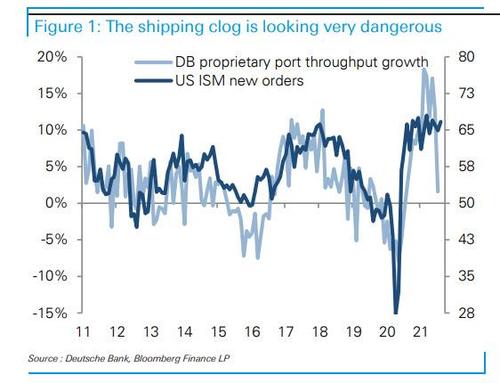
Finally, we can see that the primary problem here is not one of excess demand for goods but a breakdown in supply: global container capacity driven by supply chain disruption, has sunk to near-decade lows
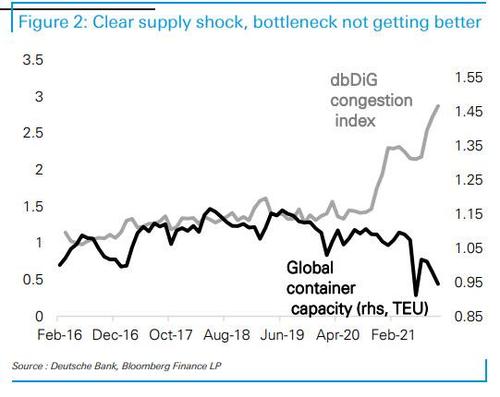
Second, Saravelos highlights how the fixed income market is already starting to price a recession in the Czech Republic where the yield curve has dramatically inverted. This is a worrisome development given Czechia’s tight links with global auto supply chains and is unsurprisingly also pointing to big downside risks to the global PMI
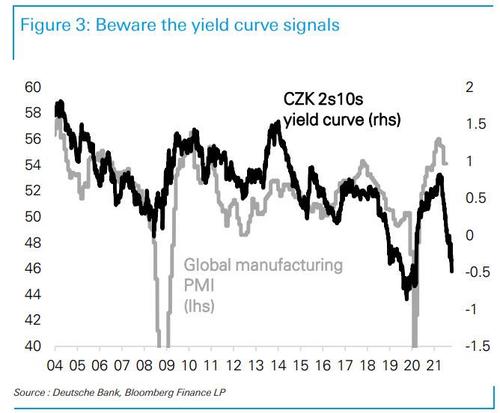
The DB strategist also ranks global yield curves by their flatness, and notes that much of the world is not that far behind from inverting
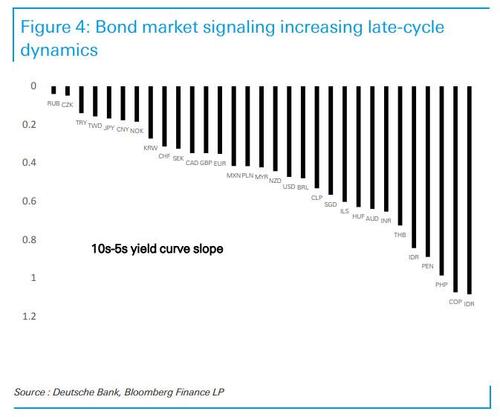
Finally, the macro read across of US bank earning results was fascinating.
America’s largest bank is sitting flush with liquidity but rather than extending this to loan growth the dominant analyst question is when will this be used to buy treasuries. DB's bank analyst thinks the bank is able to deploy up to $200bn in US security purchases in coming quarters, reflective of broader US bank holdings of government bonds that have taken off exponentially since the crisis began
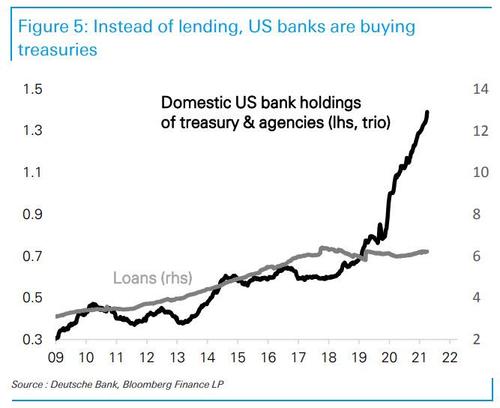
In macro terms, Americans' excess cash is not going into consumption but deposits; banks, in turn, prefer funneling liquidity back into the domestic bond market rather than extending credit as consumer demand for loans is not as attractive. This story fits in perfectly with why the US current account deficit has not widened more: US national saving rates remain too high. The US economy is proving more Ricardian or Japanese than thought.
Bringing it all together, the data remain on the pessimistic end of expectations in terms of the macro outlook. The aggressive flattening of curves in recent days is consistent with a view of a very low global r* and high excess savings interacting with an increasingly vicious negative supply shock (see here for more). As Saravelos concludes, "a poor structural growth outlook, too much saving over consumption and now rising inflation risks remain the dominant macro paradigm."
marsh
On TB every waking moment
California GOP Congressman: The Mess at Our Ports a 'Shining Example' of Democratic Policy Failures
BY GWENDOLYN SIMS OCT 28, 2021 11:12 PM ET

Cynthia Smalley/Mike Garcia For Congress via AP
On Thursday, as California’s clogged ports continued to struggle, U.S. Congressman Mike Garcia (R-CA) didn’t pull any punches when discussing exactly who he believes is to blame for the mess at our nation’s busiest ports. “I blame both the federal government and the state governments,” said Garcia in an interview with Fox News’ Stuart Varney. “This is what happens when you have life-long politicians trying to run a country when they’ve had absolutely zero business experience. Between Biden, Pelosi, and Schumer you’ve got three politicians who have earned 141 years of paychecks, all of which were as politicians–none of which were in the business world.”
Add in decades of failed leftist policies and we have a recipe for disaster. “I love my state,” said Garcia. “But from an economic perspective, it’s a wobbly top that is like two revolutions away from falling down.”
And what does the congressman see as the source of the mess at our ports? Two policies championed by Democratic politicians and environmental activists: AB-5 and CARB regulations.
AB-5 prevents California’s truckers from operating as independent contractors.
The California Air Resource Board, or CARB, is a leftist government entity that has as its vision unprecedented and aggressive carbon emissions regulations. CARB’s goal is so radical that it plans to eliminate all new vehicle emissions in the state of California within thirty years. To that end, only CARB-compliant vehicles—including trucks—are allowed to be registered in the state.
Combined, AB-5 and CARB force “truckers to leave California because they can’t operate as independent contractors,” Garcia said. If truckers “do stay, they have to buy trucks effectively every seven years even though their mileage may be low, so this is why we don’t have [many] truckers in California anymore.” Garcia knows these crippling leftist policies are examples “of how California’s policies affect the entire nation” since, as we are painfully aware, leftist policies don’t often stay in California.
Fundamentally, the mess at the ports illuminates the core differences between leftists and conservatives. While leftists fine shipping companies because they have to wait to unload their goods, conservatives believe there’s a better way of relieving the port congestion. “What they should be doing—rather than imposing fines—they should be cutting costs, incentivizing people to get out of there with lower port fees and quicker turnaround times,” explained Garcia.
“That’s how we’re going to get this thing moving.” Instead, leftists punish people who don’t do what they think they should. Conservatives believe incentives work much more effectively than punishments.
In the end, Garcia told Varney, California can fix the ports mess by allowing “truckers to operate as independent contractors, repeal[ing] AB-5, and relax[ing] the guidelines around carbon emissions.” The congressman also warned not to forget that as California goes so goes the country, while noting that instead of repealing AB-5, Democrats in Congress are working hard to nationalize it in the form of the PRO Act.
View: https://www.facebook.com/watch/?v=1699946980347301&ref=external
2:15 min
marsh
On TB every waking moment
MSN
www.msn.com
Supply chain shortage is driving up prices. Farmers are worried it could grow worse.
Phil McCausland 13 hrs ago
Joel Everett said he was astounded when a lightly used 2009 John Deere tractor sold at his last auction in Strawberry Point, Iowa, for tens of thousands of dollars more than it had cost fresh off the production line more than a decade ago.

Bought new for $109,000, the tractor sold for $143,000 at auction, he said. It's not an isolated incident, said Everett, who has run Joel’s Tractor and Auction since 1992. A lot of farm equipment, particularly used tractors, is selling for 30 percent to 50 percent more than it was two years ago at his auction house.
"It's been unreal," Everett said. "Our last sale was the biggest dollar sale we ever had, and we're fixing to have another in three to four weeks that's going to blow that one away."
Quality farm equipment is getting hard to find amid the supply chain shortage, many farmers and experts said, and its scarcity is driving up prices and raising questions about whether farmers' harvests and next year's planting season could be affected.
Some farmers are concerned that the shortage could grow worse after 10,000 John Deere workers went on strike last week. The company had reported record profits this year, and United Auto Workers union members walked off the job at 14 manufacturing plants when it refused to raise wages above 6 percent.
"It's got us worried for sure," said Eric Hopkins, the senior vice president of Hundley Farms, which boasts 20,000 acres of mostly vegetables in central Florida.
"They're already low on inventory and parts right now. A strike is only going to exacerbate things, make it worse. If it lasts for a while, not only will they not have new tractors, but when you have a breakdown and there's no parts, your tractor is just going to sit there not being able to harvest or plant a crop."

Feelings among farmers about the John Deere strike are mixed. Many said that they supported the workers' desire for a better deal but that they are worried about the effect of a strike that lasts weeks or months.
A long strike could hamper the country's food supply chain, which has suffered shortages since the start of the coronavirus pandemic, which further delayed John Deere's ability to deliver products and parts in a timely manner. Farmers also worry that a delay could affect their increasingly thin margins.
It's uncertain how long the strike could last and to what degree John Deere will be further slowed. It said it had a continuity plan in place, bringing in salaried nonunion workers to maintain some level of production.
Crops can be damaged if they are planted or harvested late, and the insurance provided by the Agriculture Department requires that seeds are put in the ground and produce is pulled by a particular date to be fully insured.
Play Video on website 2:28 min
Thousands of John Deere workers go on strike
That's one issue highlighted by David Misener, who travels the country from May to November as a custom farmer. He brings farm equipment and harvests other people's crops for them. His timelines are tight, but he's had to wait long periods for repairs and parts multiple times this season — an unusual occurrence.
Most recently, while he was working a field for a South Dakota farm this month, a bearing went out on a combine harvester, destroying one of its shafts. The only place the local dealer could find a replacement part was in Canada, and Misener had to sit on his hands for a week until it arrived.
"It is extremely crucial that we harvest on a timely schedule, because it can decide whether you have something to harvest or nothing," Misener said.
The threat to the bottom line is also scary because prices for equipment are growing, as well as for fertilizer, seed, grain and other common farm production resources.
Matt Ackley, the chief marketing officer of Ritchie Bros, which operates a global marketplace for insights, services and transaction solutions for commercial assets, including the sale of heavy equipment, said interest in and prices for farm equipment are growing considerably.

The price index for used tractors at Ritchie Bros. is up by 19 percent since last year, Ackley said. The company's website, where it hosts online auctions, has attracted more than 161 million visitors and 1.3 million bidders in 2021 — that’s up by 15 percent and 19 percent respectively from the same time a year ago.
Ackley shared an auction for a tractor that was struck by lightning this year. It was put up for auction by an insurance company as salvage. The tractor still got 393 bids Monday as prospective buyers fought for the opportunity to break it down for spare parts.
“As you get any type of disruption, especially from an [original equipment manufacturer] standpoint — like this strike — to an already stretched supply chain, you get quite a significant backlog,” said Ackley, whose team has been tracking the shortfalls in the supply chain since the pandemic started. “People are fighting vigorously for what’s left.”
The items that farmers can repair themselves are also becoming more sought-after and harder to find.
It’s an ongoing challenge. Farmers say that as agriculture equipment becomes more technical digitally, companies like John Deere have limited farmers' ability to repair their own tractors, combines and other field equipment.
Tim Riley, an organic farmer in western Kansas, said he and other farmers around him have had to get creative because of the parts shortages and the challenges of fixing their own equipment.

"Some of the electronic parts have been really hard lately to get for the guidance systems on some of these tractors," Riley said. "It's really hard to do anything with how highly computer-driven they are anymore, so that's a problem."
When the guidance system broke down on Riley's tractor, he had to call his neighbors to ask whether he could dismantle the GPS systems from their rigs to use on his. The local dealer did the same thing and called customers for help when the GPS on a tractor Riley had rented broke this year.
Riley is also worried because John Deere is already so behind in production that he's unable to buy a new tractor for planting season next year.
"Coming into our spring season, we really need a new tractor, but they told us that we won't be able to get it for a year to a year and a half," he said, adding that he has had to buy a used tractor for his farm for the next few years.
Everett, who operates the auction house in Iowa, said he knows multiple farmers who bought new John Deere combines more than eight months ago who still haven’t gotten them and bought different combines just to get through the season.
At times, he's been able to encourage farmers to buy two of the same tractor and cannibalize one for parts.
"I've been telling the guys who want to buy the new stuff at our auctions if you want one that's newer or really nice, this is all you're going to get," he said. "You used to be able to do that, but now our supply chain is just in shambles."
marsh
On TB every waking moment
24:52 min
Here is the real reason behind the trucker shortage and how to fix it
Oct 29, 2021
Wake Up America Podcast
Mainstream media has been going on and on about the trucker shortage and laying the blame on the supply chain crisis squarely on the backs of the truckers on the front lines. As someone who has worked in the trucking industry in some capacity for the past 15 years, I see what is happening now and more importantly why it is happening. I suppose I should qualify myself and why I am speaking out about this. I know most people who found our website know me from my days covering the violent and sometimes deadly riots over the past year, but in reality, the news business was always a side venture. When I was 20 I started my first trucking company. It was almost on accident. I needed to make money, found someone who needed to ship something so I hauled it. After a while, that company grew from one truck to several and we continued to grow. I have literally worked in nearly all positions in the industry, probably because of my management style, rather than necessity. I like to have things done the way I want them, and in life, I have found the only way to have this happen is to do them yourself. I’ve operated my own warehouses and loaded every truck. I hired, trained, managed, dispatched, and paid all of my drivers. When I transitioned into the brokerage and 3pl side of the industry, I attacked it the same way I have always. I grew a freight agency from startup to $7 million in revenue in nine months. I managed a sales book of tens of millions. I’ve consulted with some of the largest carriers, shippers, and third-party logistics firms over the years. I truly love the industry. Well, most of it, I guess. The truck driver shortage myth is one thing I don't like.
marsh
On TB every waking moment

Ep95 - Breaker! Breaker! We Got Ourselves a SHUTDOWN! Blue Collar Blockade to Cripple Supply Chain Over Vax Mandates Is ON! - MAGA Institute
Attorney Leigh Dundas joins the MAGA Institute Podcast to share the seismic event that will rock this nation next month. As Leigh notes, this country runs on the backs of our blue-collar workers who manufacture, transport, and stock all the products in our stores, generate all our electricity...
Breaker! Breaker! We Got Ourselves a SHUTDOWN! Blue Collar Blockade to Cripple Supply Chain Over Vax Mandates Is ON!
ByMAGA Institute
28 October 2021

Attorney Leigh Dundas joins the MAGA Institute Podcast to share the seismic event that will rock this nation next month. As Leigh notes, this country runs on the backs of our blue-collar workers who manufacture, transport, and stock all the products in our stores, generate all our electricity, run our airports, etc.
Axe the Vax Walkout Employees in the healthcare, education, telecom, and supply chain/transport industries, as well as public sector employees whose employers are mandating the genetic therapy injections are organizing a national strike from November 8th-11th to bring the economy to its knees, so people can see what an impact illegal vax mandates will have on their lives.
Stand strong and stand together!
As people who have been paying attention know, there are NO FDA-approved shots currently available in the United States. FDA played bait-and-switch with two smoke and mirrors letters issued the same day to provide political cover for corrupt politicians and corporations to begin mandating that people get jabbed…or else.
What actually occurred was that the first letter concerned a Biological License Application (BLA) was approved, to permit marketing of COMIRNATY, which is NOT currently available in the United States, provided that the marketing materials are subsequently approved. The second letter said that the Pfizer/BioNTech formulation was clinically identical to COMIRNATY. It did NOT “approve” the Pfizer/BioNTech injection.
That is the reason they’re dropping the hammer so hard and so fast to now coerce people into getting jabbed after months of cajoling them with freebies.
Speed is their only ally. The longer you resist, the less time they will have to compel your compliance, because the lawsuits currently working their way through the legal system will enjoin them from requiring injections.
Leigh said that the best recourse people who are having their livelihoods threatened by their employer is to find likeminded fellow employees and resist en masse. There truly is power in numbers, as the recent experience at Southwest Airlines proved. Many employees of large employers have set up websites to organize their resistance strategy. If your company is mandating you get jabbed and either doesn’t have an employee group or you don’t know whether you already have an organized effort underway, go to vaxmandateinfo.com to be connected with your fellow employees and join this national strike.
An American Issue, Not a Partisan Issue
Leigh noted that the ferocity with which these anti=Constitutional mandates have been rolled out has united Americans of all walks of life and all political views around this issue. She said that in just a few weeks, we’ve gone from worrying about being attacked by antifa and BLM at our rallies to them marching with us to oppose these violations of our fundamental, God-given rights and personal sovereignty.
And there is precedent for such action. Leigh was in Thailand when the farmers drove their tractors to Bangkok to protest new agricultural laws, which the government ended up recinding. She saw first-hand the power and impact of people standing together and clogging highways with tractors and other farm equipment.

German Farmers Protesting at Berlin’s Brandenburg Gate
Similar actions have taken place elsewhere around the globe, including Australia, Germany, and India. Leigh says that farm and heavy equipment can be used both offensively and defensively. Offensively, highway and port blockades using semis/tractor-trailers, tractors and other farm machinery, and heavy equipment cannot easily be removed by the powers-that-be. Defensively, if every operator simply “misplaced” his or her keys or didn’t show up for work in the first place, leaving that equipment sitting idle for four days, the effect on the economy and the message it would send would be overwhelming.

Farmers in India Block Major Highways to Protest Subsidy Prices

marsh
On TB every waking moment
ZeroHedge
ZeroHedge - On a long enough timeline, the survival rate for everyone drops to zero
Carriers Must Move 60K Containers Out Of Los Angeles/Long Beach By Halloween
SATURDAY, OCT 30, 2021 - 03:30 PM
By Lori Ann LaRocco of FreightWaves,
Halloween is going to be an extra scary day for the logistics world. A total of 60,000 containers have been marked as beyond the dwell time and need to be moved out of the ports of Los Angeles and Long Beach by the carriers or the penalties will start racking up. A total of 33,000 containers need to be rolled out of the Port of Los Angeles and 27,000 loaded containers for the Port of Long Beach — a whopping $2,633,940,000 value in trade.
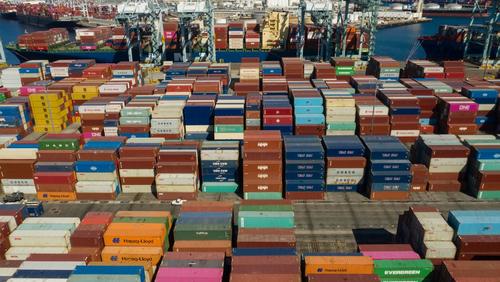
Carriers were put on notice this week when the ports announced that, starting next Monday, a daily surcharge of $100 per container will be levied. Did this light a fire and a surge of containers being moved? No.
The pace of trade moving out of the ports could be characterized as more of a pregnant pause than a surge. Live webcams of the Port of Los Angeles terminals show more images of empty lanes than robust activity.
Turn times at both terminals tracked by the Harbor Trucking Association and GeoStamp also paint the snail pace of trade both before and after the announcement.

“We are having an emergency harbor meeting Friday morning to vote on this,” explained Port of Los Angeles Executive Director Gene Seroka. “I need to see progress on the movement of loaded containers. We need to show America we are doing whatever we can to get trade moving.”
Noel Hacegaba, COO of the Port of Long Beach, emphasized this container push would be significant in alleviating the congestion plaguing productivity.
“This is roughly 40% of all containers sitting on the terminals today,” he said.
“Pulling all of these containers by Sunday will take an unprecedented coordinated effort but it must be done.”
Importers have told American Shipper they are afraid they will be on the hook for the fees. Some have already received letters notifying them of the additional charges.
“The carriers have always passed on fees and surcharges,” said one importer who asked for anonymity out of fear of retaliation. “Why would the Biden
administration, which is behind this penalty, think the carriers would not pass it over? The Federal Maritime Commission is already looking into the excessive demurrage costs we are paying! Carriers are making record profits.”
Maersk sent a letter to customers on Wednesday detailing the penalties.
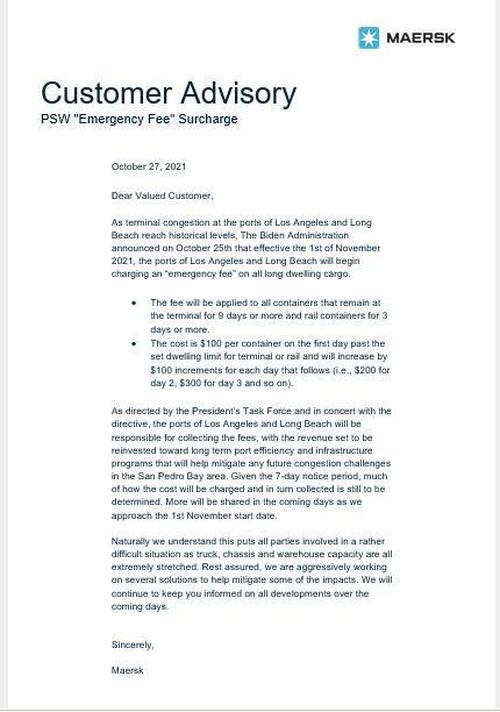
When asked if the penalties would be passed over to customers, Maersk responded it was a work in progress since it has clients that have clauses in their contracts that stipulate no new additional charges.
“This penalty was not intended to be a passed-on cost,” explained Mario Cordero, Port of Long Beach executive director, at a port update press conference. Hacegaba added, “We are using every tool at our disposal to move containers.”
The National Retail Federation and the American Apparel and Footwear Association tell American Shipper if these charges are passed on, it will only add to the mounting inflationary logistic charges importers have been paying.
Hacegaba stressed, “We need the entire supply chain to step up.”
marsh
On TB every waking moment

Greenfield: California Drove Truckers Out of Business. Now Store Shelves Are Empty » Politichicks.com
What happens in California unfortunately doesn’t stay there unless it’s waiting on a ship.
Greenfield: California Drove Truckers Out of Business. Now Store Shelves Are Empty
 Daniel Greenfield Send an email17 hours ago
Daniel Greenfield Send an email17 hours ago
After a long cross-country flight, I made it out of LAX and into an Uber. I wasn’t in the mood to talk, but the driver was. And hearing that I was a journalist, he wanted to tell me a story. I’ve heard a lot of stories over the years, but this may have been the most important one I let go.
He hadn’t always been driving an Uber at 11:30 at night. Not all that long ago he used to have his own business with 7 trucks before he was bankrupted by California’s insane regulations.

I listened, but didn’t pay enough attention. The impact of California’s Democrat legislative supermajority on truckers was just another data point alongside what was happening to freelancers of all kinds and a lot of small businesses. Stories like this were everywhere and there was little interest in them even in conservative circles outside the tarnished golden state.
Back then we still lived in a world where you could walk into a thousand stores with fully stocked shelves. People ordered from Amazon and expected its burgeoning last mile delivery service to make products magically appear overnight. Just in time inventory systems were more efficient and any day now products would be delivered by self-driving cars or aerial drones.
2020 and 2021 have given this Big Tech fantasy world and the rest of us a good kicking.
The massive supply chain mess that’s leaving stores empty and orders unfulfilled doesn’t have a single point of failure, but dozens of them. China’s energy shortages, the overhyped predictive powers of Big Data, the fragility of the global economy, fuel costs, and welfare state worker shortages are all players. But California’s truck bans are a key link in the great failure chain.
While I was riding home that night, California trucking companies were going bankrupt at a rapid rate. Few outside the industry were paying attention or understood what that might mean.
2019 was described as a “bloodbath” for the trucking industry with 640 trucking companies across the country filing for bankruptcy in just the first half of the year. Thousands of truck drivers were left unemployed. Many went into the expanding last mile delivery business, some as contractors for Amazon. But California truckers and businesses had their own special woes.
Two years ago, Governor Newsom signed the Democrat supermajority’s Assembly Bill 5 into law. While AB5 was billed as a crackdown on Uber and Lyft, forcing the companies to treat l freelance contractors as employees, the gig economy companies pushed Proposition 22 so that they were the only ones exempt from the law. (A Democrat judge has since illegally blocked the approved ballot measure while falsely claiming that it was unconstitutional.)
AB5 however was less about Uber than it was about outlawing freelance employees in order to force them into unions. The union power grab inconvenienced Uber and Lyft, but crushed freelance workers in a variety of fields including journalism. One of the fields was trucking.
Over the summer, the California Trucking Association actually went to the Supreme Court to fight AB5 and allow owners and operators to use independent contractors. The CTA listed 70,000 owner operators. In the years since AB5, Ubers have become scarcer and more expensive, which is what the law was actually designed to do, but the consequences to the trucking industry have been far worse albeit invisible to most people until now. While truckers are still protected from AB5, many in the industry are not willing to bet their future on SCOTUS.
AB5 was not only the assault on the trucking by California Democrats who were aggressively trying to unionize the industry and to impose environmental regulations on it.
Last year, the California Air Resources Board issued a press release boasting that it had taken a “bold step to reduce truck pollution”. The bold step required switching to electric trucks.
“We are showing the world that we can move goods, grow our economy and finally dump dirty diesel,” Jared Blumenfeld, California’s Secretary for Environmental Protection, sneered.
Jared and California certainly showed the world something.
While the ultimate truck ban was scheduled for 2045, an initial phase-in of 5% to 9% begins in 2024. Last year, California’s DMV began refusing to register thousands of trucks with an estimated 100,000 trucks under threat. With “green” trucks costing $70,000 more, this was a non-starter for already troubled independent owner-operators and even larger companies.
That was part of the plan.
California Democrats and their environmentalist special interests had set out to crush the state’s ports and trucking industry. Had everything gone as planned, this would have been a slow and gradual process. Costs would have crept up and deliveries would have fallen off without an immediate catastrophic impact. But then the pandemic and its consequences arrived.
Business at California’s ports dropped during the pandemic. The loss of traffic convinced trucking companies and owner operators who were already battered by AB5 and the green truck ban that it was better to just downsize or pull out entirely. And when port activity rebounded, there was a huge hole in the delivery infrastructure that backed up the entire system.
Biden called for ports to operate around the clock, but that’s not going to magically bring back thousands of trucks or truckers. California Democrats still haven’t changed their regulations and without that, there’s no incentive or even legal structure that would allow trucks to operate.
The resulting disaster is likely to accelerate the ongoing shift of shipping from California ports. Democrats imposed their green shakedown not only on truckers, but on shipping. With companies moving to Texas, Houston was already becoming a more appealing alternative. It’s now at capacity as everyone is looking for alternatives to the California economic disaster area.
But much of our imports and exports still depend on the California bottleneck that begins with Communist China and ends in Communist California. The red-to-red pipeline has savaged our economy and wrecked imports and exports.
Newsom’s survival and the Dem legislative supermajority which passes more extreme leftist regulations every session means that things will only get worse. A radical party that actively seeks to dismantle the economy is in power in Sacramento and its regulations have the ability to hold our entire economy hostage.
What happens in California unfortunately doesn’t stay there unless it’s waiting on a ship.
[COMMENT: Sorry if this is a repeat. It sounds awfully familiar. I went back 5 days and didn't see it.]
marsh
On TB every waking moment

Buttigieg wishes he were still on maternity leave…
Chrissy Wallace makes Buttigieg sweat Even CNN brought up the issue this morning Yes it’s photoshopped
 citizenfreepress.com
citizenfreepress.com
.41 min
Chrissy Wallace makes Buttigieg sweat
Even CNN brought up the issue this morning
.35 min
Yes it’s photoshopped

marsh
On TB every waking moment
ZeroHedge
ZeroHedge - On a long enough timeline, the survival rate for everyone drops to zero
The Fed's Inflation Is Behind The Supply Chain Mess
BY TYLER DURDEN
SUNDAY, OCT 31, 2021 - 10:30 AM
Authored by Ryan McMaken via The Mises Institute,
It seems supporters of the Biden administration finally settled on a narrative they like for explaining away supply chain shortages.
Here’s the administration’s talking point:
the US economy is rolling along so well that Americans are demanding huge amounts of goods.
For example, transportation secretary Buttigieg this month declared "Demand is up … because income is up, because the president has successfully guided this economy out of the teeth of a terrifying recession."That’s overwhelming the supply chain and causing the backups roiling America’s ports and logistic infrastructure.
Similarly, White House spokeswoman Jen Psaki told reporters supply chain problems are occurring because “people have more money … their wages are up … we’ve seen an economic recovery that is underway.”
This position has been mocked by a number of conservative politicians—including Senator Ted Cruz—and commentators, who find this to be an absurd assumption. Indeed, Cruz and other critics could point to a variety of factors ranging from the weight of government regulations to the problem of covid lockdowns limiting the productivity of supply-chain workers.

Yet the administrator’s defenders are right about consumer demand and spending—even if for the wrong reasons. As Mihai Macovei showed earlier this month, the global volume of trade and shipping volume in 2021 have actually exceeded prepandemic numbers. For example, in the port of Los Angeles, “loaded imports” and “total imports” for the 2020–21 fiscal year (ending June 30, 2021) were both up when compared to the same period of the 2018–19 fiscal year.
In other words, it’s not as if little is moving through these ports. In fact, more is moving through them than ever before. That suggests demand is indeed higher.
But why is it higher? It some ways, it's true that, as Psaki says, "people have more money." That, however, is where the veracity and usefulness of Biden’s defenders end in explaining the problem.
Much of the answer can be really found in monetary inflation. Obviously, Joe Biden hasn’t “successfully guided the economy” through anything, but it is accurate to say that people have more money in a nominal sense. Wages are up nominally. After all, if we look at the immense amount of new money created over the past eighteen months, we should absolutely expect people to have more money sloshing around. But this also means a lot more pressure on the logistical infrastructure as people buy up more consumer goods.
The idea that supply chain problems are “driving inflation” gets the causation backward. It’s money supply inflation that’s causing much of the supply chain's problems. Not the other way around.
After all, as of September 2021, M2 has increased from $15.2 trillion to $20.9 trillion since February 2020. That’s an increase of 35 percent. Yes, some of that has been kept within the banking system through the Fed’s payment of interest on reserves, but a lot of it clearly has entered the “real economy” through stimulus payments, unemployment insurance, and federal deficit spending in general.
Originally, the public was saving a lot of that stimulus and bailout money, with the personal savings rate hitting historic highs of over 25 percent. But this past summer the savings rate collapsed again, and as of September is back under 8 percent. The public is now flooding the economy with its former savings.
The American appetite for spending on consumer goods hasn’t gone away.
Yet there are many reasons to suspect this spending spree is unsupported by actual economic activity and is a phenomenon of monetary inflation.
For example, today’s tsunami of spending raises questions when we consider there are still about 5 million fewer people working in the American economy than was the case in early 2020. That means fewer people being paid wages.
Without monetary inflation, an economy with millions of fewer workers suggests there should be less spending.
Additionally, spending increases when the public suspects that inflation is going to increase. That is, if there is a perception the value of money will decline, the demand for money will decline also. As Ludwig von Mises noted: “[O]nce public opinion is convinced … the prices of all commodities and services will not cease to rise, everybody becomes eager to buy as much as possible and to restrict his cash holding to a minimum size.”
That means more spending. This phenomenon is already clear in home prices and grocery prices. The public may suspect rising prices are here to stay. Meanwhile, the Consumer Price Index—a very limited measure of goods price inflation—is nonetheless near a thirty-five-year high. That means now’s a good time to spend.
With 2020's panic-induced saving subsiding, people are now wondering if their savings produce any returns. But ordinary savers are surely now remembering that the interest returns from savings right now are next to nothing. Thanks to the central bank’s ultralow interest rate policy, we live in a yield-starved world. That’s okay for hedge funders who can participate in carry trades and other high-yield forms of investment. But regular people are stuck with interest rates that don’t keep up with price inflation. So it makes more sense to spend dollars rather than save them.
So, Biden’s people are correct in a certain sense that people have “more money” and that “demand is up.” This is just what we would expect in an inflationary environment.
We should expect demand for everything (but money) to be up.
The question, however, is how much of this windfall will continue in real, inflation-adjusted terms. It’s too early to tell, although we can also see that inflation-adjusted median earnings collapsed 6.3 percent, year over year, during the second quarter of 2021. We can see that real GDP growth has dramatically slowed.
But at least as far as the third quarter is concerned, it’s fairly clear the US was—and likely still is—in the midst of an inflationary boom. But how long will it last?
marsh
On TB every waking moment
ZeroHedge
ZeroHedge - On a long enough timeline, the survival rate for everyone drops to zero
I've Been Driving Trucks For 20 Years, I'll Tell You Why America's "Shipping Crisis" Will Not End
SUNDAY, OCT 31, 2021 - 06:30 PM
Authored by Ryan Johnson via Medium.com,
I have a simple question for every ‘expert’ who thinks they understand the root causes of the shipping crisis:
Why is there only one crane for every 50–100 trucks at every port in America?
No ‘expert’ will answer this question.
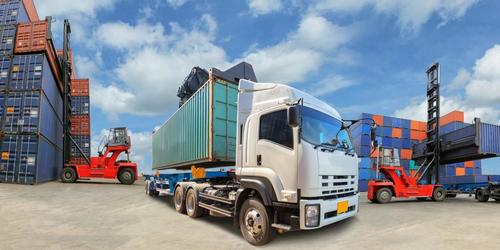
I’m a Class A truck driver with experience in nearly every aspect of freight.
My experience in the trucking industry of 20 years tells me that nothing is going to change in the shipping industry.
Let’s start with understanding some things about ports.
Outside of dedicated port trucking companies, most trucking companies won’t touch shipping containers. There is a reason for that.
Think of going to the port as going to WalMart on Black Friday, but imagine only ONE cashier for thousands of customers. Think about the lines. Except at a port, there are at least THREE lines to get a container in or out. The first line is the ‘in’ gate, where hundreds of trucks daily have to pass through 5–10 available gates.
The second line is waiting to pick up your container. The third line is for waiting to get out. For each of these lines the wait time is a minimum of an hour, and I’ve waited up to 8 hours in the first line just to get into the port. Some ports are worse than others, but excessive wait times are not uncommon. It’s a rare day when a driver gets in and out in under two hours. By ‘rare day’, I mean maybe a handful of times a year. Ports don’t even begin to have enough workers to keep the ports fluid, and it doesn’t matter where you are, coastal or inland port, union or non-union port, it’s the same everywhere.
Furthermore, I’m fortunate enough to be a Teamster — a union driver — an employee paid by the hour. Most port drivers are ‘independent contractors’, leased onto a carrier who is paying them by the load. Whether their load takes two hours, fourteen hours, or three days to complete, they get paid the same, and they have to pay 90% of their truck operating expenses (the carrier might pay the other 10%, but usually less.) The rates paid to non-union drivers for shipping container transport are usually extremely low. In a majority of cases, these drivers don’t come close to my union wages. They pay for all their own repairs and fuel, and all truck related expenses. I honestly don’t understand how many of them can even afford to show up for work. There’s no guarantee of ANY wage (not even minimum wage), and in many cases, these drivers make far below minimum wage. In some cases they work 70 hour weeks and still end up owing money to their carrier.
So when the coastal ports started getting clogged up last spring due to the impacts of COVID on business everywhere, drivers started refusing to show up.
Congestion got so bad that instead of being able to do three loads a day, they could only do one. They took a 2/3 pay cut and most of these drivers were working 12 hours a day or more. While carriers were charging increased pandemic shipping rates, none of those rate increases went to the driver wages.
Many drivers simply quit. However, while the pickup rate for containers severely decreased, they were still being offloaded from the boats. And it’s only gotten worse.
Earlier this summer, both BNSF and Union Pacific Railways shut down their container yards in the Chicago area for a week for inbound containers. These are some of the busiest ports in the country. They had miles upon miles of stack (container) trains waiting to get in to be unloaded. According to BNSF, containers were sitting in the port 1/3 longer than usual, and they simply ran out of space to put them until some of the ones already on the ground had been picked up. Though they did reopen the area ports, they are still over capacity.
Stack trains are still sitting loaded, all over the country, waiting to get into a port to unload. And they have to be unloaded, there is a finite number of railcars. Equipment shortages are a large part of this problem.
One of these critical shortages is the container chassis.
A container chassis is the trailer the container sits on. Cranes will load these in port. Chassis are typically container company provided, as trucking companies generally don’t have their own chassis units. They are essential for container trucking. While there are some privately owned chassis, there aren’t enough of those to begin to address the backlog of containers today, and now drivers are sitting around for hours, sometimes days, waiting for chassis.
The impact of the container crisis now hitting residencies in proximity to trucking companies. Containers are being pulled out of the port and dropped anywhere the drivers can find because the trucking company lots are full. Ports are desperate to get containers out so they can unload the new containers coming in by boat. When this happens there is no plan to deliver this freight yet, they are literally just making room for the next ship at the port. This won’t last long, as this just compounds the shortage of chassis. Ports will eventually find themselves unable to move containers out of the port until sitting containers are delivered, emptied, returned, or taken to a storage lot (either loaded or empty) and taken off the chassis there so the chassis can be put back into use. The priority is not delivery, the priority is just to clear the port enough to unload the next boat.
What happens when a container does get to a warehouse?
A large portion of international containers must be hand unloaded because the products are not on pallets. It takes a working crew a considerable amount of time to do this, and warehouse work is usually low wage. A lot of it is actually only temp staffed. Many full time warehouse workers got laid off when the pandemic started, and didn’t come back. So warehouses, like everybody else, are chronically short staffed.
When the port trucker gets to the warehouse, they have to wait for a door (you’ve probably seen warehouse buildings with a bank of roll-up doors for trucks on one side of the building.) The warehouses are behind schedule, sometimes by weeks. After maybe a 2 hour wait, the driver gets a door and drops the container — but now often has to pick up an empty, and goes back to the port to wait in line all over again to drop off the empty.
At the warehouse, the delivered freight is unloaded, and it is usually separated and bound to pallets, then shipped out in much smaller quantities to final destination. A container that had a couple dozen pallets of goods on it will go out on multiple trailers to multiple different destinations a few pallets at a time.
From personal experience, what used to take me 20–30 minutes to pick up at a warehouse can now take three to four hours. This slowdown is warehouse management related: very few warehouses are open 24 hours, and even if they are, many are so short staffed it doesn’t make much difference, they are so far behind schedule. It means that as a freight driver, I cannot pick up as much freight in a day as I used to, and since I can’t get as much freight on my truck, the whole supply chain is backed up. Freight simply isn’t moving.
It’s important to understand what the cost implications are for consumers with this lack of supply in the supply chain. It’s pure supply and demand economics.
Consider volume shipping customers who primarily use ‘general freight’, which is the lowest cost shipping and typically travels in a ‘space available’ fashion.
They have usually been able to get their freight moved from origination to delivery within two weeks. Think about how you get your packages from Amazon. Even without paying for Prime, you usually get your stuff in a week. The majority of freight travels at this low cost, ‘no guarantee of delivery date’ way, and for the most part it’s been fine for both shippers and consumers. Those days are coming to an end.
People who want their deliveries in a reasonable time are going to have to start paying premium rates. There will be levels of priority, and each increase in rate premium essentially jumps that freight ahead of all the freight with lower or no premium rates. Unless the lack of shipping infrastructure is resolved, things will back up in a cascading effect to the point where if your products are going general freight, you might wait a month or two for delivery. It’s already starting.
If you use truck shipping in any way, you’ve no doubt started to see the delays.
Think about what’s going to happen to holiday season shipping.
What is going to compel the shippers and carriers to invest in the needed infrastructure? The owners of these companies can theoretically not change anything and their business will still be at full capacity because of the backlog of containers. The backlog of containers doesn’t hurt them. It hurts anyone paying shipping costs — that is, manufacturers selling products and consumers buying products. But it doesn’t hurt the owners of the transportation business — in fact the laws of supply and demand mean that they are actually going to make more money through higher rates, without changing a thing. They don’t have to improve or add infrastructure (because it’s costly), and they don’t have to pay their workers more (warehouse workers, crane operators, truckers).
The ‘experts’ want to say we can do things like open the ports 24/7, and this problem will be over in a couple weeks. They are blowing smoke, and they know it. Getting a container out of the port, as slow and aggravating as it is, is really the easy part, if you can find a truck and chassis to haul it. But every truck driver in America can’t operate 24/7, even if the government suspends Hours Of Service Regulations (federal regulations determining how many hours a week we can work/drive), we still need to sleep sometime. There are also restrictions on which trucks can go into a port. They have to be approved, have RFID tags, port registered, and the drivers have to have at least a TWIC card (Transportation Worker Identification Credential from the federal Transportation Security Administration). Some ports have additional requirements. As I have already said, most trucking companies won’t touch shipping containers with a 100 foot pole. What we have is a system with a limited amount of trucks and qualified drivers, many of whom are already working 14 hours a day (legally, the maximum they can), and now the supposed fix is to have them work 24 hours a day, every day, and not stop until the backlog is cleared. It’s not going to happen. It is not physically possible. There is no “cavalry” coming. No trucking companies are going to pay to register their trucks to haul containers for something that is supposedly so “short term,” because these same companies can get higher rate loads outside the ports. There is no extra capacity to be had, and it makes NO difference anyway, because If you can’t get a container unloaded at a warehouse, having drivers work 24/7/365 solves nothing.
What it will truly take to fix this problem is to run EVERYTHING 24/7: ports (both coastal and domestic), trucks, and warehouses. We need tens of thousands more chassis, and a much greater capacity in trucking.
Before the pandemic, through the pandemic, and really for the whole history of the freight industry at all levels, owners make their money by having low labor costs — that is, low wages and bare minimum staffing. Many supply chain workers are paid minimum wages, no benefits, and there’s a high rate of turnover because the physical conditions can be brutal (there aren’t even bathrooms for truckers waiting hours at ports because the port owners won’t pay for them. The truckers aren’t port employees and port owners are only legally required to pay for bathroom facilities for their employees. This is a nationwide problem). For the whole supply chain to function efficiently every point has to be working at an equal capacity. Any point that fails bottlenecks the whole system.
Right now, it’s ALL failing spectacularly TOGETHER, but fixing one piece won’t do anything. It ALL needs to be fixed, and at the same time.
How do you convince truckers to work when their pay isn’t guaranteed, even to the point where they lose money?
Nobody is compelling the transportation industries to make the needed changes to their infrastructure. There are no laws compelling them to hire the needed workers, or pay them a living wage, or improve working conditions. And nobody is compelling them to buy more container chassis units, more cranes, or more storage space. This is for an industry that literally every business in the world is reliant on in some way or another.
My prediction is that nothing is going to change and the shipping crisis is only going to get worse. Nobody in the supply chain wants to pay to solve the problem. They literally just won’t pay to solve the problem. At the point we are at now, things are so backed up that the backups THEMSELVES are causing container companies, ports, warehouses, and trucking companies to charge massive rate increases for doing literally NOTHING. Container companies have already decreased the maximum allowable times before containers have to be back to the port, and if the congestion is so bad that you can’t get the container back into the port when it is due, the container company can charge massive late fees. The ports themselves will start charging massive storage fees for not getting containers out on time — storage charges alone can run into thousands of dollars a day. Warehouses can charge massive premiums for their services, and so can trucking companies. Chronic understaffing has led to this problem, but it is allowing these same companies to charge ten times more for regular services. Since they’re not paying the workers any more than they did last year or five years ago, the whole industry sits back and cashes in on the mess it created. In fact, the more things are backed up, the more every point of the supply chain cashes in. There is literally NO incentive to change, even if it means consumers have to do holiday shopping in July and pay triple for shipping.
This is the new normal. All brought to you by the ‘experts’ running our supply chains.
marsh
On TB every waking moment

Biden's Supply Chain Speech in Italy Sounded Like Italian Dictator Benito Mussolini "The Trains Will Run On Time" | The Gateway Pundit | by Joe Hoft
Guest post by Bob Bishop The G20 (comprising 19 countries and the European Union) met in Rome this past weekend to address the global supply chain crisis, international taxes, and climate change.
Biden’s Supply Chain Speech in Italy Sounded Like Italian Dictator Benito Mussolini “The Trains Will Run On Time”
By Joe Hoft
Published November 1, 2021 at 3:50pm

Guest post by Bob Bishop
The G20 (comprising 19 countries and the European Union) met in Rome this past weekend to address the global supply chain crisis, international taxes, and climate change. Three of America’s largest importers China, Japan, and Mexico leaders, were absent.
President Biden held a press conference focusing on the fragility of the global supply chains. Biden’s Rome speech finished by channeling Italian Dictator Benito Mussolini by quoting the need for “the trains run on time.”
Then we have to prevent this from happening again, in the future. Now that we have seen how vulnerable these lines of global commerce can be, we cannot go back to business as usual. This last pandemic won’t be the last global health crisis we face.
Many of our supply chains are almost entirely owned and operated by the private sector. But government can play a key role identifying supply chain risks and bringing the different pieces and actors together to address these vulnerabilities.
Last week in a futile attempt, Biden ordered the Los Angeles and Long Beach ports to work 24/7. Still, a shortage of rail workers and qualified professional truck drivers means continued bottlenecks. Also, there are punitive fines for container shipping delays. This Bureaucratic incompetency doesn’t inspire confidence.To insure our supply chains are free from forced and child labor. Supporting the dignity and the voice of workers and are in line with our climate goals.
Biden claims the Build Back Better spending bill will rescue the system by providing billions in funding to fix the private supply chains and provide monitoring and oversight.
Centralized Command Economy
Biden is moving towards an old-style Soviet Union command economy of issuing logistic regulations and objectives for producing, distributing, and consuming goods. Next on his agenda, we can anticipate a state planning committee to devise operational plans and destructive price controls to contain inflationary prices.
The Soviet Command economy created empty shop shelves and long waiting lines. Biden’s economy is now doing the same just in time for Christmas.
Vilification of Just-In-Time Supply Chains
The global just-in-time supply chain (JIT) is based on suppliers stripping out redundancies, streamlining efficiency, and eliminating waste resulting in lower-cost products for consumers. JIT manufactures and distributes products at the right time in the right amounts based on customer demand. Absent panic buying, JIT worked well for decades until the mandated pandemic lockdowns disrupted the supply chains.
Biden’s cure is to force the private sector to take on more costs by re-engineering logistics, creating redundancies and inventory stockpiles to overhaul the JIT supply chains. It will create further disruptions and much higher consumer prices.
Gallup Poll – ‘Government Has Too Much Power’
Last September, the Gallup Poll found that 52% of the public favor a more limited government role. There has been a shift where American’s believe that the government is regulating business too much. The public also prefers lower taxes and fewer government services. Most American’s realize government regulation creates a covert tax known as inflation. Biden could care less about public sentiment.
“I am from the Government, and I am here to help.”
President Ronald Reagan’s famous quote addresses the folly of progressive policymaking. Dogmatic mandates and regulations don’t make our lives easier.
Bob Bishop is a retired corporate CPA
marsh
On TB every waking moment
Will Fines Finally Solve the Port Problem or Just Make Things Worse?
BY GWENDOLYN SIMS NOV 01, 2021 8:14 PM ET
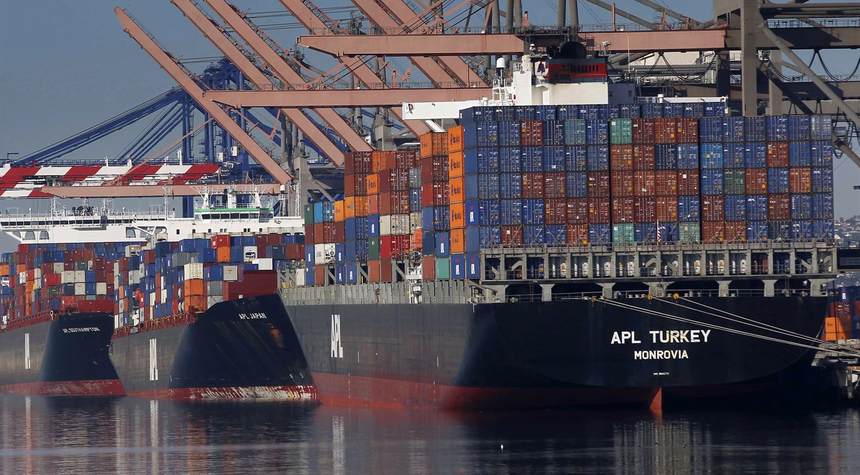
(AP Photo/Nick Ut, File)
As of November 1, the Container Excess Dwell Fee is in effect for both the Long Beach and Los Angeles ports. Fines will be accessed and start accumulating after November 15 for all arriving containers. Shipping companies with containers set to move by trucks that dwell on the docks past nine days and containers set to move by rail that stay at the ports past three days will be fined $100 per container. After the initial three or nine days, shipping companies will be fined an incremental increase of $100 per container per day.
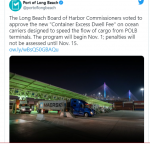
“Containers that linger too long on the docks are delaying the berthing of vessels, leading to record numbers of ships waiting off the coast, and consumers and businesses across the U.S. left waiting for crucial shipments,” the Long Beach commissioners said in a statement to KTLA.
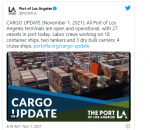
“This is the nation’s leading cargo gateway, and this crisis has national impacts,” said Port of Long Beach Executive Director Mario Cordero. “We need to take action to facilitate the rapid movement of cargo through the supply chain.”
While some public officials are convinced these fines along with longer hours of port operation, the relaxing of stacking ordinances for containers, and other measures will work to ease the unprecedented shipping backlog, other officials aren’t so certain.
Fundamentally, the mess at the ports illuminates the core differences between leftists and conservatives. While leftists fine shipping companies because they have to wait to unload their goods, conservatives believe there’s a better way of relieving the port congestion. “What they should be doing—rather than imposing fines—they should be cutting costs, incentivizing people to get out of there with lower port fees and quicker turnaround times,” explained GOP Congressman Mike Garcia (R-CA) in an interview with Fox News. “That’s how we’re going to get this thing moving.”
Garcia isn’t alone in believing that decades of failed leftist policies have only made things worse at our ports. There are two policies in particular that are championed by Democratic politicians and environmental activists: AB-5 and CARB regulations.
Instead, leftists punish people who don’t do what they think they should. Conservatives believe incentives work much more effectively than punishments.'
In the end, those fines don’t hurt the multi-billion dollar shipping companies because they will simply pass on those fines to the consumer in the form of higher prices. To see incentives successfully at work, we need only look to the busy and unclogged ports of Florida and Texas.
View: https://twitter.com/i/status/1455192049754517504
.30 min
Meanwhile, despite mainstream media’s breathless claims to the contrary, the country’s busiest ports remain stubbornly clogged because so far nothing President Biden, Governor Newsom, or other officials have decreed has incentivized the unions to want to pay longshoreman overtime to work longer hours, more truckers to work under California’s onerous regulations, or lowering port fees and making turnaround times faster so shipping companies can leave the ports quicker. Until these incentives are offered, we can be sure the backlog and congestion at our ports will continue and fines will only make things worse for consumers.
L.A.B.
Goodness before greatness.
Soooo, Uncle Joe says he has been working on the backlog for months.Now he is going to make the LA port start working 24/7. I would have thought that ports already work 24/7.
Have they been keeping bankers hours and we didn't know???
This and everything else that has to do with shortages of people running equipment, truck drivers and other jobs above the fast food jobs have a lot to do with the fact that the baby boomers are retiring. The younguns for the most part don't do this type of job they are computer jockeys.
Came across this story this afternoon… thanks for posting it here…I was just about to.
THIS … is the heart of the problem…the lack of incoming food, appliances, raw materials, computer chips. Hell, EVERYTHING we are quickly running out of.
This is the bottleneck, and California is reason for the problem every American is now facing…staring down the barrel of an intentional shotgun…aimed at every one of us.
This falls DIRECTLY into Piglosi’s lap…and as every single one of us know, she is directly behind this Armageddon…and every single empty shelf in America.
The original story was an extremely long winded request for federal control.
If the author was honest he would likely find a large amount of the blame is directly the result of administration policies and leftist demo run coastal state moronic governors, and the reliance on Chinese goods flowing through California ports.
And the solution is give these morons more control?????
See definition of insanity...
Lessons learned.
China in an emergency will take care of China and give the middle finger to the rest of the world.
California cannot be relied on in any emergency because of leftist progressive leaders in the state.
Obama is an even worse president running things from the shadows as he was when he was in the oval office.
Complex problems can never be solved by the government. Unless it was the military before the election theft.
I was aware of the little PAC that met with the CA governor, and who they were 12 hours after the fact. Trusted FOAF report.
Their approach was quite the green-bean pipe dream off into the future. Your typical coffee full of giddy smiles and sweets approach, where flat tables with plans and physical models replicating a marine operation should have been implemented to drive home the point of alleviating competing stowage and traffic on [ONE SIDE OF 1/2 of an isle.
Marine terminal operations are repetitive cycles of chaos fed by:
[Gate-Yard]
[Yard-Yard] ‘Pitch & Catch Consolidating’
[Vessel Loadout-Exports]
[Vessel Discharge - Grounded or Wheeled] with respect to Local deliveries [Transtainer Rows] or [Reefer-Stacks], or [Hub sorted Rail Cargo-CONUS IMPORTS & EXPORTS.
As you can see, there is always a lot of multi-directional traffic * in the atypical 20 hours the ports in So-Cal are open for between 07:00 through 03:00.
The secret to taming the chaos for more efficient operations within the confines of a marine terminal is as simple as not competing for the same traffic lane as the operation that had fed your operation earlier.
Stow side… and
Flow side…
Back of the stow pile, (1st can down) [dated cargo] becomes… first can selected in the next delivery operations…. The complimenting operation does not create a traffic pattern on the same side of the [BIG STACK OF CONTAINERS].
Lot’s of tricks the poli-hacks have no perspective of. Therefore the CA governor can pass EO’s all day long and not help much despite such stroke of the pen efforts.
Get our truckers back in the game. That’s a huge fix!
Last edited:
L.A.B.
Goodness before greatness.
The Teamster Trucker article from Zero Hedge is about 90% SPOT-ON. I like his reference about un-palleted cargo, creating a swamping/ Swamper’s nightmare when devanning at the warehouses.
What his perspective does not account for, at least his 20 recent years, is the manner of former, Pre-Y2K faster delivery using Top-Handler’s to deliver to truckers, instead of today’s multi-handling Transtainer’s.
He should know, if he comes in for a particular container, it may have [four containers] on top of it…
Sorry Bud. Your can’s not gonna sprout wings and fly out of the stack.
[SOME 1’S ELSE’S CAN]
[SOME 1’S ELSE’S CAN]
[SOME 1’S ELSE’S CAN]
[SOME 1’S ELSE’S CAN]
[HERE THIS IS MY CAN]
We have to reshuffle the stack for your request.
It could be worse, like having a Block-Stow-Stack and have 21 other containers in front of yours.
OPEN BOOKINGS & VETTED DRIVERS with LAT-LON Coordinates as a in house (terminal) delivery system.
The container has a number. It should have a GEO-tag address too. THATS how you FLOW CANS OUT OF THE STACKS for Efficient Delivery.
What his perspective does not account for, at least his 20 recent years, is the manner of former, Pre-Y2K faster delivery using Top-Handler’s to deliver to truckers, instead of today’s multi-handling Transtainer’s.
He should know, if he comes in for a particular container, it may have [four containers] on top of it…
Sorry Bud. Your can’s not gonna sprout wings and fly out of the stack.
[SOME 1’S ELSE’S CAN]
[SOME 1’S ELSE’S CAN]
[SOME 1’S ELSE’S CAN]
[SOME 1’S ELSE’S CAN]
[HERE THIS IS MY CAN]
We have to reshuffle the stack for your request.
It could be worse, like having a Block-Stow-Stack and have 21 other containers in front of yours.
OPEN BOOKINGS & VETTED DRIVERS with LAT-LON Coordinates as a in house (terminal) delivery system.
The container has a number. It should have a GEO-tag address too. THATS how you FLOW CANS OUT OF THE STACKS for Efficient Delivery.
Last edited:
marsh
On TB every waking moment
ZeroHedge
ZeroHedge - On a long enough timeline, the survival rate for everyone drops to zero
No Trucking Way
TUESDAY, NOV 02, 2021 - 09:09 AM
By Michael Every of Rabobank
The financial economy and real economy used to live with each other happily: now they are in a long-distance relationship reliant on logistics to keep in touch. What happens when those logistics break down? (Very bad things, as I was discussing here the other day.)
We have covered the ocean-carrier side of this crisis (‘In Deep Ship’), and the new fee equivalent to $1m a day, and rising $1m each following day, for a 10,000 TEU vessel whose cargo is stuck in LA/LB port. However, we stressed in that report that the supply chain issue is more systematic. So, allow me to share quotes from an article exposing there is ‘No Trucking Way’ we are about to return to normal:
“Think of going to the port as going to WalMart on Black Friday, but imagine only ONE cashier for thousands of customers…Most port drivers are ‘independent contractors’, leased onto a carrier who is paying them by the load. Whether their load takes two hours, fourteen hours, or three days to complete, they get paid the same, and they have to pay 90% of their truck operating expenses…I honestly don’t understand how many of them can even afford to show up for work…In some cases they work 70 hour weeks and still end up owing money to their carrier.
The author also points out a crippling shortage of truck chassis; warehouse workers, again due to low-pay and Covid, so unloading takes longer; and warns soon there will be less, not more truck drivers. Crucially, he bewails that ocean carriers, ports, trucking companies, warehouses, and retailers are all making great money – so won’t invest before the system collapses further. If so, this book-ends the 1980 deregulation of the US trucking industry under President Carter.So when the coastal ports started getting clogged up last spring due to the impacts of COVID on business everywhere, drivers started refusing to show up. Congestion got so bad that instead of being able to do three loads a day, they could only do one. They took a 2/3 pay cut and most of these drivers were working 12 hours a day or more…Many drivers simply quit. However, while the pickup rate for containers severely decreased, they were still being offloaded from the boats. And it’s only gotten worse…The ‘experts’ want to say we can do things like open the ports 24/7, and this problem will be over in a couple weeks. They are blowing smoke, and they know it.”
Meanwhile, Senator Manchin just said ‘No Trucking Way’ to the White House’s fiscal plans, again, which already fail to address the above logistical problems. Perhaps it’s time for US economists to study what weak, share-cropper logistics and on-off fiscal and central-bank liquidity largesse do for emerging markets’ macroeconomic and financial stability?
Indeed, Bloomberg reports: “Chinese households are encouraged to stock up on a certain amount of daily necessities, such as vegetables and meat, in preparation for the winter months, according to a notice from Ministry of Commerce aimed at ensuring supply and stabilizing prices of such items for the next few months. Major agricultural distributors are encouraged to sign long-term contracts with producers. Reserves of meat and vegetables will be released on a timely basis to replenish market supply.” At least they are being proactive on supply chains.
This news, the US trucking/logistics tragedy, and much else that is going around us in politics collectively reminds me of a classic Soviet joke:
It’s winter in a rural town in the 70’s USSR. The town radio crackles: “All comrades, please come to the town square to receive a ration of fresh red meat!” The people gather, hungrily. The radio continues: “Please wait to receive your ration from the glorious Soviet system!” After a frosty hour, the radio says: “We regret there is not as much meat as we had expected. All Jews, go home now.” One third of the town trudges off. After another bitter hour, the radio says: “We regret there is not as much meat as we had expected. All non-Party members, go home now.”
So, that’s the real economy for you – and ironically, four decades of neoliberalism has delivered a supply-chain system that in some ways risks becoming as structurally inefficient as six decades of central planning. For years, I have quipped that just as the USSR wrestled with its self-admitted structural problems, and yet always ended up building another statue of Marx or Lenin as a can-kicking compromise, so neoliberalism says Build Back Better….and then builds another skyscraper plutoflat or business park. Even in space now. Which the Soviets also did while still not being able to feed their people properly, by the way.Another third walk off. After another two freezing hours, the radio says: “We regret there is no meat today. Go home now. Glory to the Soviet Union!” As people are leaving, one man turns to another and asks: “Why do the Jews always get the preferential treatment?”
And what does that mean for the financial economy? Nothing, apparently - central banks are acting like the Soviet voice over the radio!
- Today it’s the RBA. What exactly can they say to calm volatile markets given they are tipped to retreat from their policy of yield curve control (YCC) even though it costs them nothing to retain it, and in doing so, the market will chatter louder about when the first rate hike comes – and it will not be late 2024 they have in mind? I doubt the RBA will come up with a sophisticated way to sell a humiliating and prima facie unjustified-by-data policy U-turn today. They will probably just tweak a few key phrases in their statement, and may even retain the 0.1% YCC target while de facto ignoring it. In short, parading with the calm dignity of an emperor with no clothes, as the little boy of the yield curve points at them in hysterics, yelling “Policy error!” The housing-market hysterics, of a different sort, will begin later.
- Of course, it’s the Fed’s turn tomorrow, so any bad Aussie headlines will only last just over 24 hours, and then the brickbats can head at a different set of dingbats. As Philip Marey notes in his FOMC preview: “During the press conference Powell is likely to stress again that the end of tapering does not automatically mean the start of hiking. And that the high inflation readings are transitory. We’ll put $5 in the Atlanta Fed’s swear jar.”
Thunberg, who of course wasn’t invited to Glasgow, seems to think so on the former at least. She says there is ‘No Trucking Way’ this confab will produce the desired outcome. We shall see.
L.A.B.
Goodness before greatness.
Can't they move the containers offsite into another storage yard away from the port and sort it out there?
I don’t recall what year, possible around 2007 or so, we were encouraging Longshoremen to train for a Class 1 Truckers license to do such local drayage. At the time, the local drayage small truck companies were covering it, as well as the bigger ones.
The perfect storm is our CA green-truck laws, the steamships getting OUT OF THE CHASSIS BUSINESS, and CV-19 stay at home stimulus $$,$$$. The small independent trucker, selling off his ‘dirty truck’ into a flooded market because of Green-Truck-Port laws.
Sure, he (the little independent) can come back into the trucking industry for a BIG COMPANY, get treated fiscally like an independent, then be forced into The Jab!
It should be very clear by now, this design to fail is working well!
The threat of these vaXX MANDATES in the Trucking & Waterfront industry will be the final blow to welcoming LOGISTICAL-NATIONAL-INFRASTRUCTURE SUICIDE.
ALL WAR IS LOGISTICS, and this CV-19 LIC Asymmetric PSYOP-Biowarfare game is about to establish the losers.
BFT2X’s about this America! Or ewe will lose.
Last edited:

